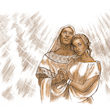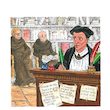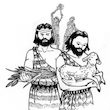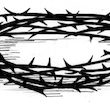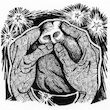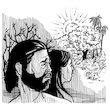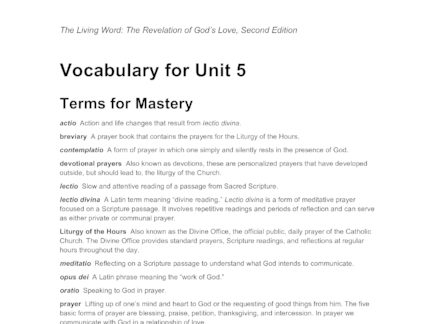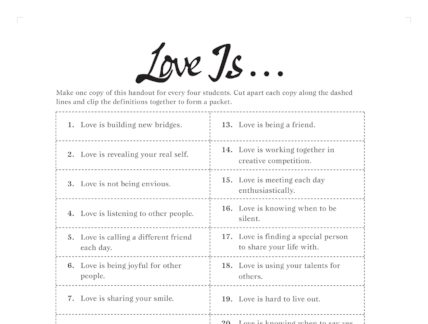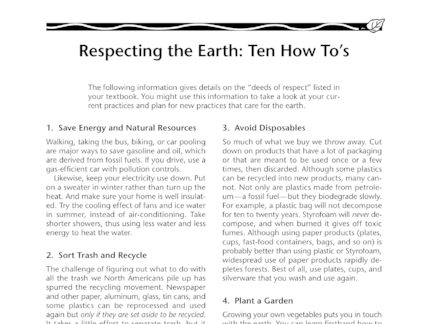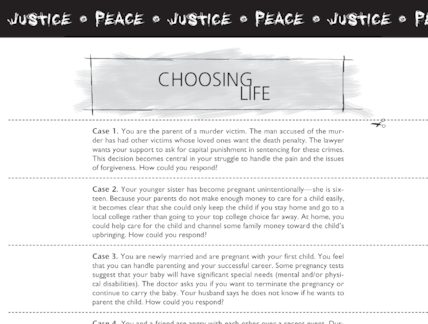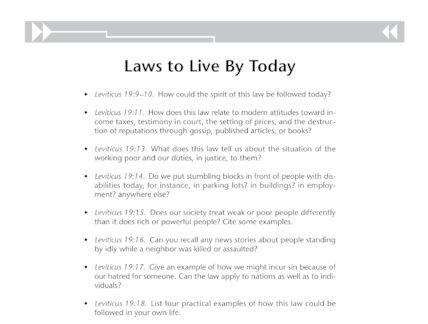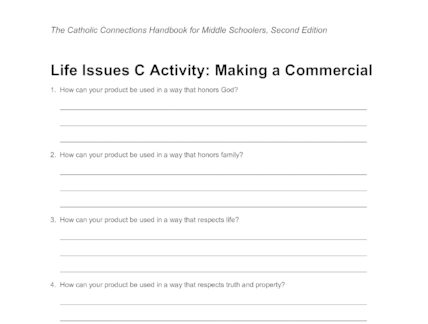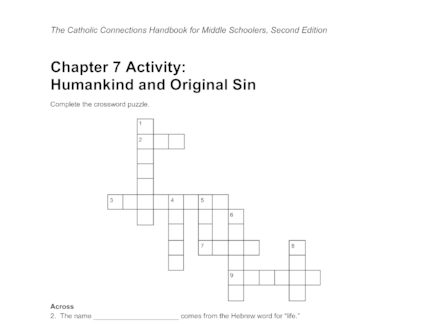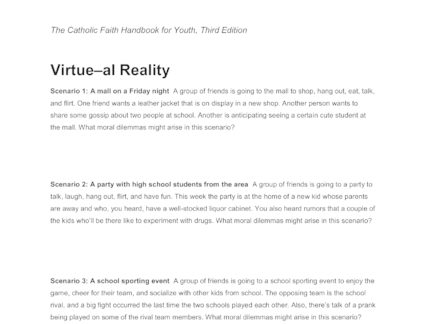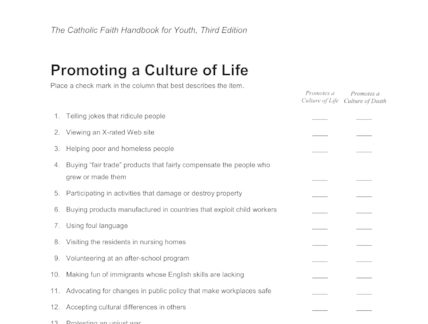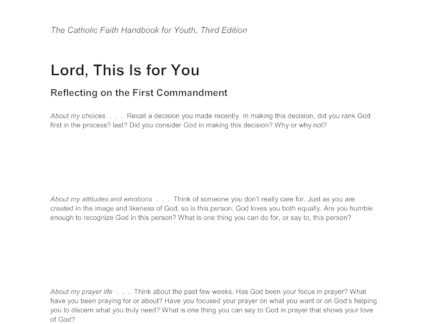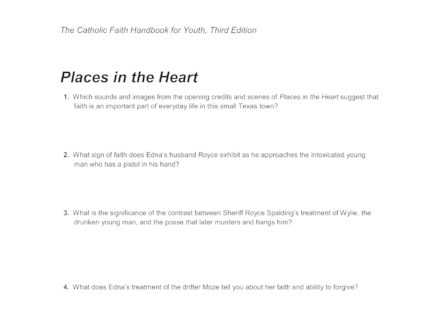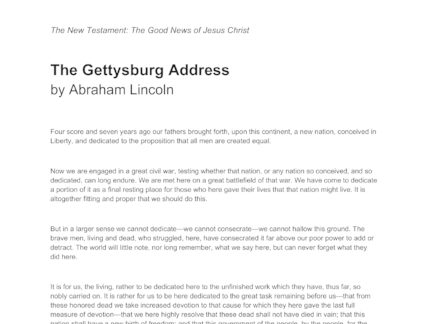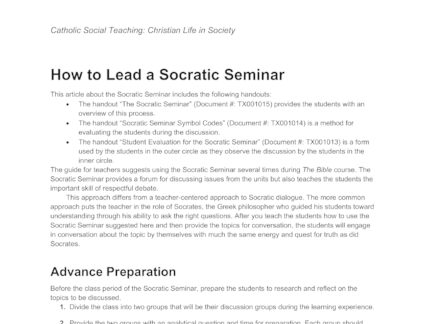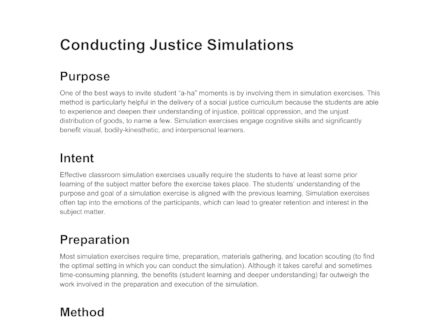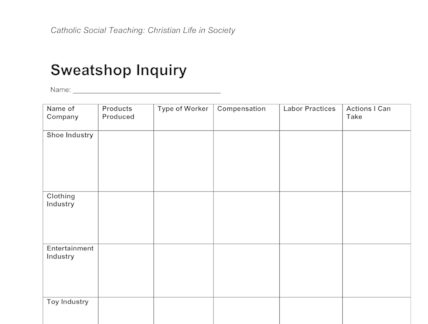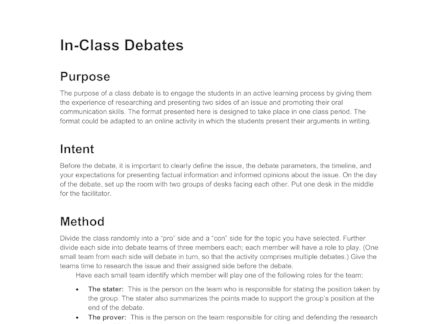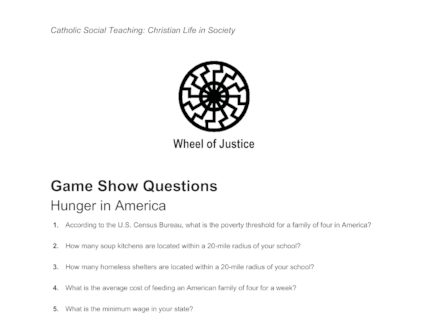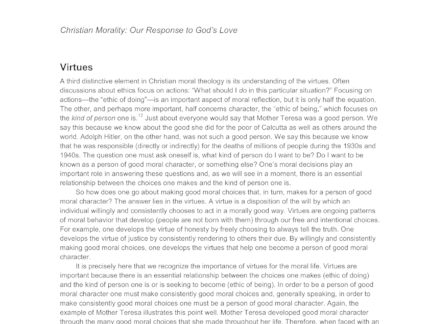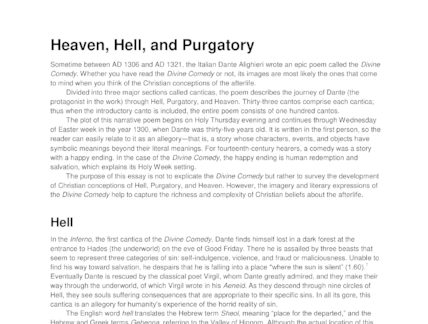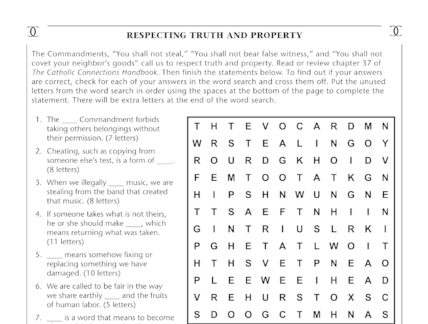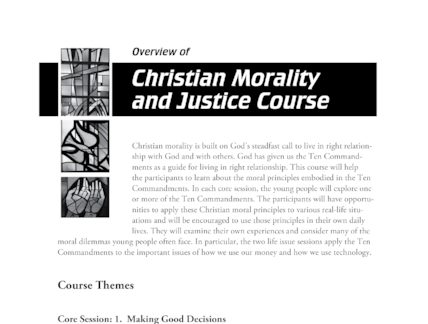Morality
Showing 1–455 of 455 results. View 24 per page View 200 per page.
Video
CST 101 | Call to Family, Community, and Participation
Video
CST 101 | Option for the Poor and Vulnerable
Video
Kid President - How to Change the World (a work in progress)
Video
The Body of Christ
Video
CST 101 | Life and Dignity of the Human Person
Video
CST 101 | Care for God's Creation
Video
Pope Francis Joins Religious Leaders of Different Faiths, in Fight against Modern Slavery
Video
Don’t Laugh at Me
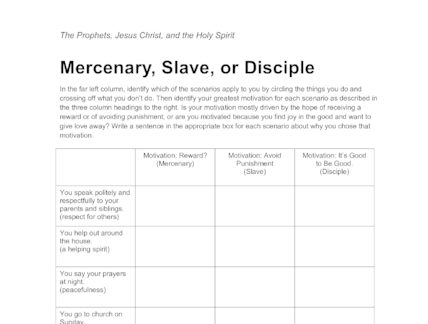
Document
Mercenary, Slave, or Disciple
Students identify their motivation for doing good deeds before reflecting on the role of grace in their lives.
Video
Consider the Lilies
Video
St. Teresa's Prayer
Video
Open the Eyes of My Heart
Video
Let Faith Arise
Video
Do This in Memory
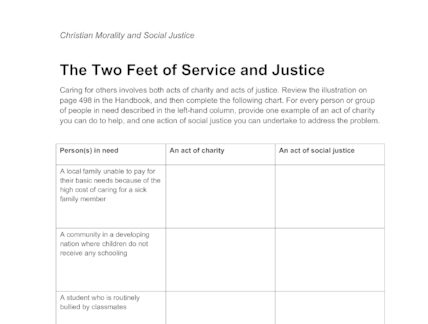
Document
The Two Feet of Service and Justice
This chart provides students space to create examples of acts of charity and social justice for several real-life situations.
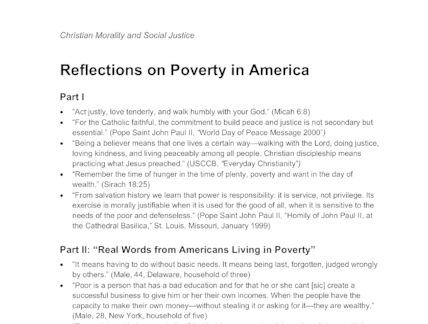
Document
Reflections on Poverty in America
This handout provides a series of Scripture passages and real-life accounts to help students reflect on poverty in America.
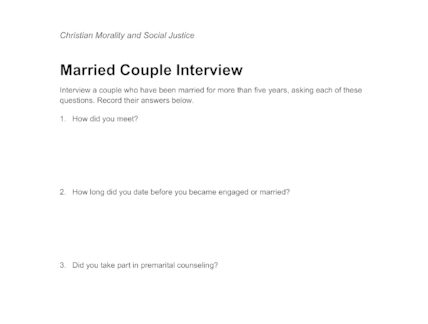
Document
Married Couple Interview
This handout provides the outline for an interview of a married couple.
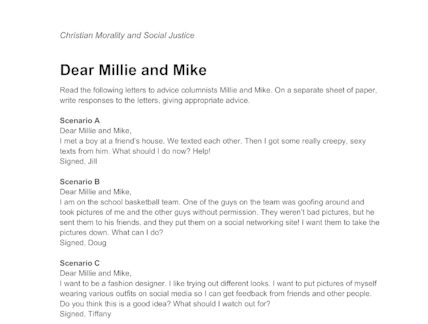
Document
Dear Millie and Mike
This handout provides several real-life situations that teens might encounter. Students are challenged to respond to the situations and give advice to other teens.
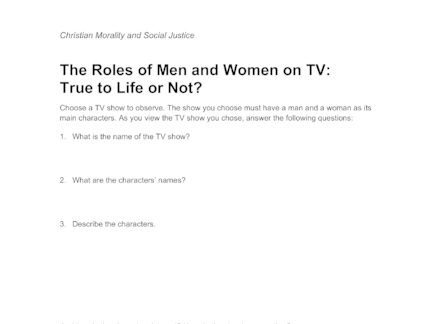
Document
The Roles of Men and Women on TV: True to Life or Not?
This handout provides questions for students to answer as they observe the roles of men and women on TV.
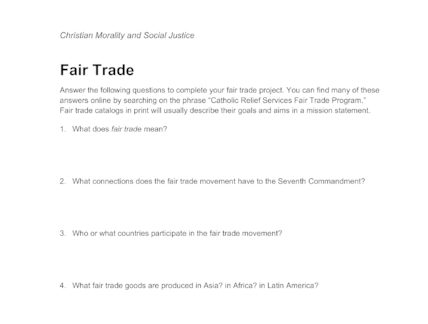
Document
Fair Trade
This worksheet provides questions for students to answer as they research and learn about the Fair Trade Movement.
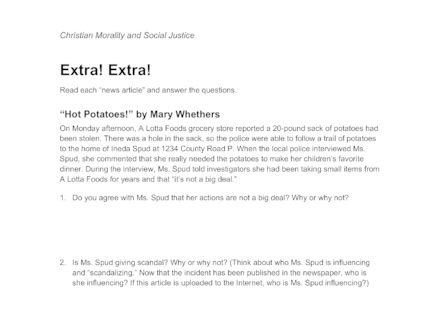
Document
Extra! Extra!
Students read two “news articles” and evaluate the morality of each by answering a series of questions.
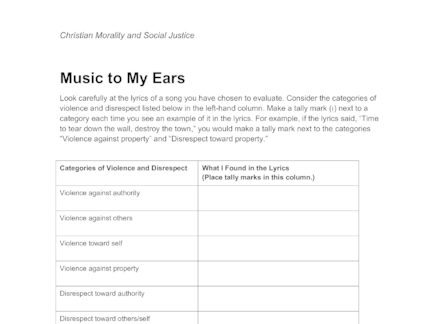
Document
Music to My Ears
Students evaluate a contemporary piece of music based on several different categories of violence and disrespect.
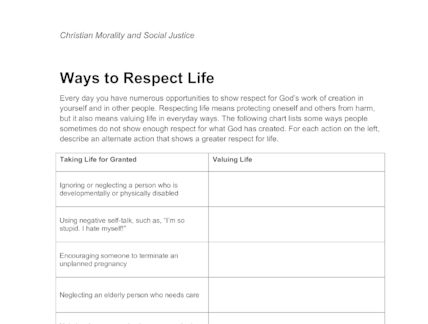
Document
Ways to Respect Life
This worksheet challenges students to think about how they can value the dignity of life on a day-to-day basis.
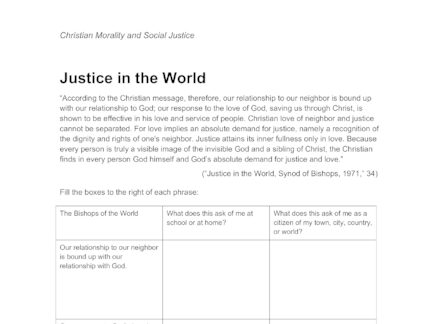
Document
Justice in the World
This worksheet challenges students to think about how the teachings about Justice from the Bishops of the World apply to their daily lives.
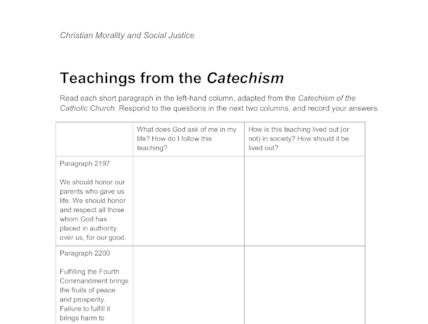
Document
Teachings from the Catechism
This worksheet challenges students to think about how the teachings from the Catechism on the fourth commandment apply to their daily lives.
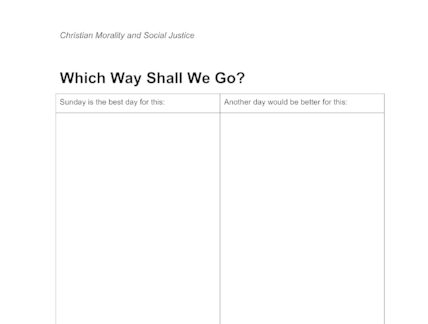
Document
Which Way Shall We Go?
This handout provides a chart for students to list activities that are best to do on Sunday and those that should be saved for other days of the week.

Document
A Doctrinal Scavenger Hunt
A scavenger hunt to find important Church doctrines, teachings and beliefs in the Catechism.
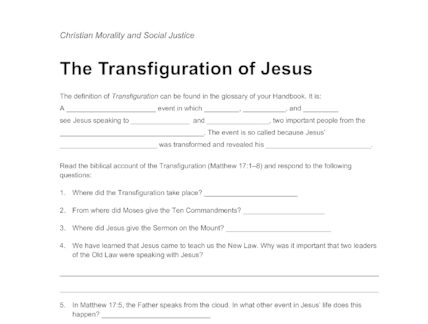
Document
The Transfiguration of Jesus
This worksheet helps students to read Scripture passages, answer questions about, and understand the importance of the Transfiguration of Jesus.
Video
Song/video "Lord, I Need You"
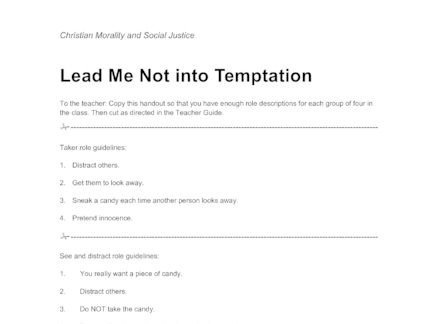
Document
Lead Me Not into Temptation
This handout presents different roles for students to act out from a real-life theft situation
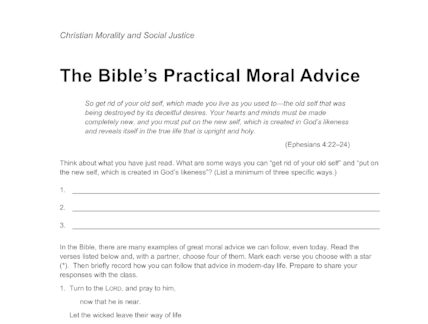
Document
The Bible’s Practical Moral Advice
This worksheet guides students as they look up Scripture passages that give moral advice.
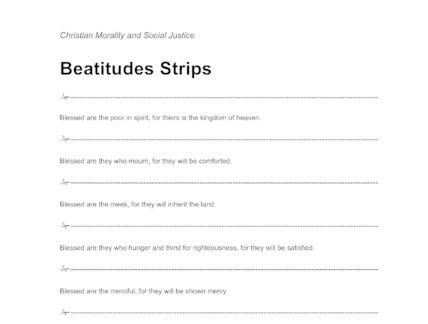
Document
Beatitudes Strips
A list of the Beatitudes organized to be cut into strips for a class activity.
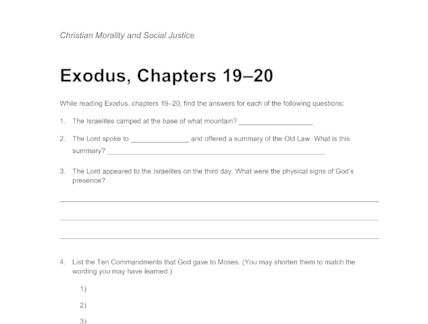
Document
Exodus, Chapters 19–20
This handout provides a note-taking guide while reading chapters 19-20 from Exodus.
Video
Here I Am, Lord (Nature Scenes)
Video
The Face of Christ (Black & White)
Video
Come to the Water
Video
What Is Catholic Social Teaching?
Video
Words
Video
Saint Mother Teresa—Inspiring ‘Everyone, Everywhere,’
Video
What Is Social Justice?
Video
Voices of Youth on Social Justice
Video
Wrecking Ball
Video
Song/video "Man in the Mirror"
Video
"Praise God from Whom All Blessings Flow"
Video
Crystalina’s Testimony (Part 1)—Love or Lust?
Video
Hold Me
Video
Servant Song
Video
Song "You Are Near"
Video
Hey, World
Video
Hope in Front of Me
Video
Live Like That
Video
Speak Life
Video
Seek Ye First
Video
Song "Word of God Speak"
Video
Video "God Speaks to Man: The Oldest Revelation"
Video
Song/video "God of Wonders”
Video
Ask Me
Video
Hey, World
Video
The Color of Love
Video
Here I Am, Lord
Video
Precepts of the Church
Video
What Are Sins?
Video
Holy Choices: Good Decision Making
Video
The Cardinal Virtues, Part 4: Courage
Video
The Cardinal Virtues, Part 3: Temperance
Video
The Cardinal Virtues, Part 2: Justice
Video
The Cardinal Virtues, Part 1: Prudence
Video
Help Me Find It
Video
The Sermon on the Mount and the Lord’s Prayer
Video
The Parable of the Unforgiving Servant
Video
The Parable of the Unforgiving Servant
Presentation
What Is Faith?
This PowerPoint accompanies Unit 5, Chapter 13, by discussing more deeply the meaning of faith and its connection to religion and belief.
Presentation
Jesus Reveals Our Inherent Dignity
<p>This PowerPoint accompanies Unit 4, Chapter 10, by discussing the inherent dignity of all life as shown to us by Jesus.</p>
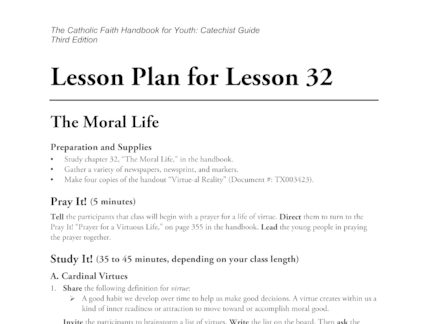
Document
Lesson Plan for Lesson 32
A lesson plan for lesson 32 in The Catholic Faith Handbook for Youth: Catechist Guide. In this lesson students explore what it means to use virtues and grace to live a moral life.
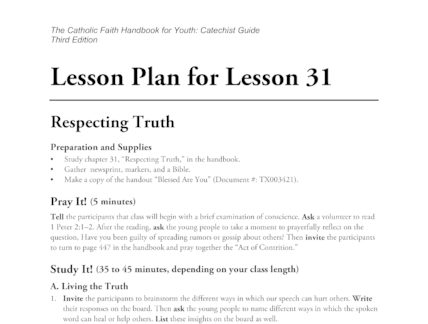
Document
Lesson Plan for Lesson 31
A lesson plan for lesson 31 in The Catholic Faith Handbook for Youth: Catechist Guide. In this lesson students explore what it means to respect truth.
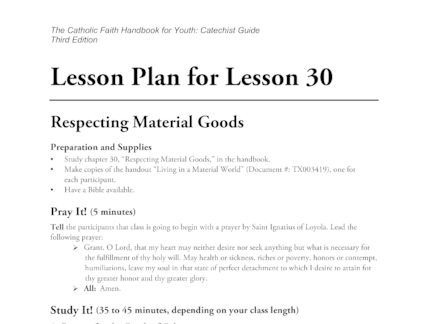
Document
Lesson Plan for Lesson 30
A lesson plan for lesson 30 in The Catholic Faith Handbook for Youth: Catechist Guide. In this lesson students explore what it means to respect material goods.
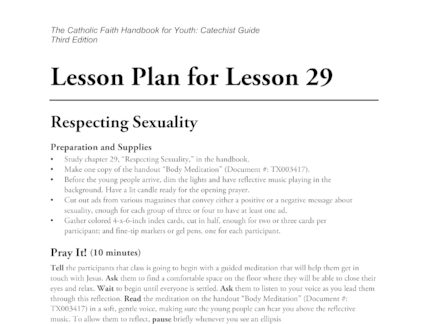
Document
Lesson Plan for Lesson 29
A lesson plan for lesson 29 in The Catholic Faith Handbook for Youth: Catechist Guide. In this lesson students explore what it means to respect the sexuality of ourselves and others.
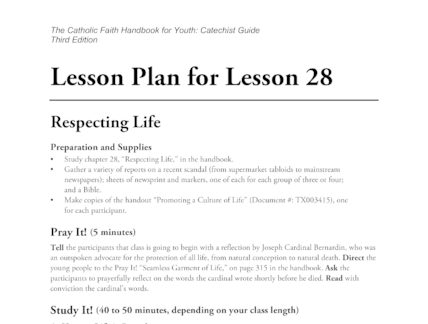
Document
Lesson Plan for Lesson 28
A lesson plan for lesson 28 in The Catholic Faith Handbook for Youth: Catechist Guide. In this lesson students explore what it means to truly respect life.
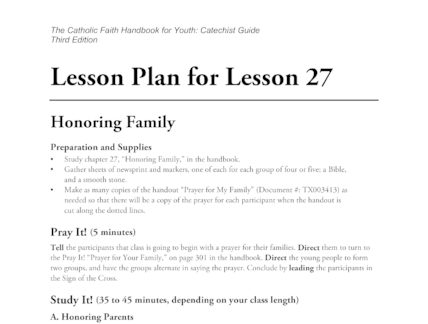
Document
Lesson Plan for Lesson 27
A lesson plan for lesson 27 in The Catholic Faith Handbook for Youth: Catechist Guide.
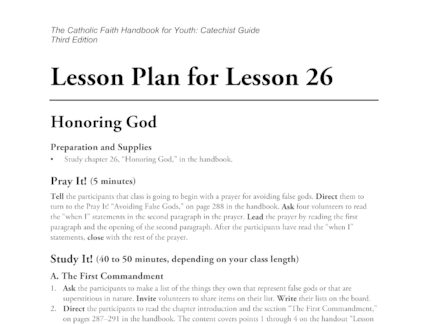
Document
Lesson Plan for Lesson 26
A lesson plan for lesson 26 in The Catholic Faith Handbook for Youth: Catechist Guide.

Document
Lesson Plan for Lesson 25
A lesson plan for lesson 25 in The Catholic Faith Handbook for Youth: Catechist Guide.
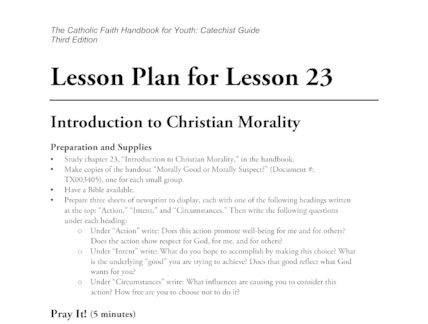
Document
Lesson Plan for Lesson 23
A lesson plan for lesson 23 in The Catholic Faith Handbook for Youth: Catechist Guide.
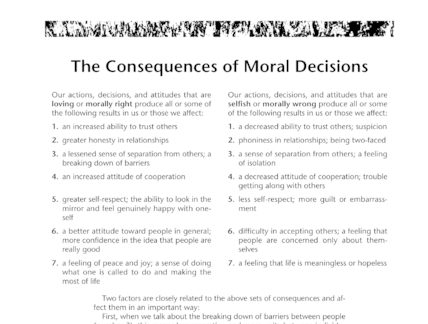
Document
The Consequences of Moral Decisions
This handout examines how actions, attitudes, and decisions affect ourselves and the people around us
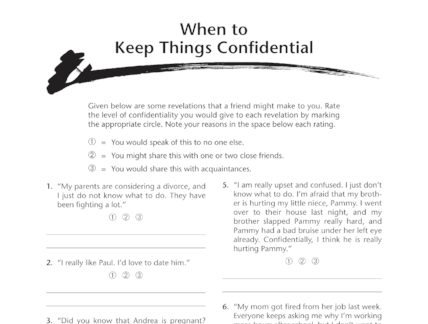
Document
When To Keep Things Confidential
After reading several pieces of information that might be shared by a friend, students decide which should be kept confidential and which might be shared with others.
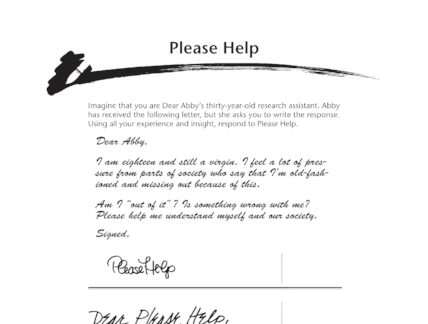
Document
Please Help
This is a writing prompt to help students reflect on what it is like to be a virgin in society today.
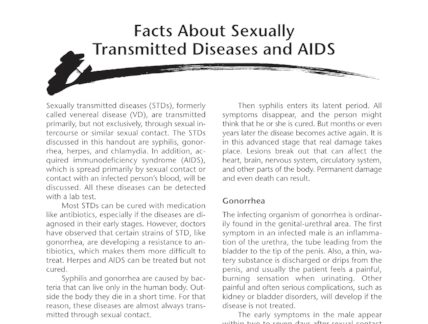
Document
Facts About Sexually Transmitted Diseases and AIDS
This article gives information about common STDs and AIDS.

Document
Questionnaire on Sexually Transmitted Diseases and AIDS
This handout provides a list of True/False statements about sexually transmitted diseases and AIDS.
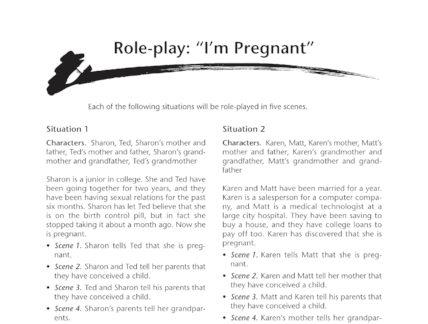
Document
Role-play: "I'm Pregnant"
This handout provides two role-play situations in which a couple has discovered they are pregnant.
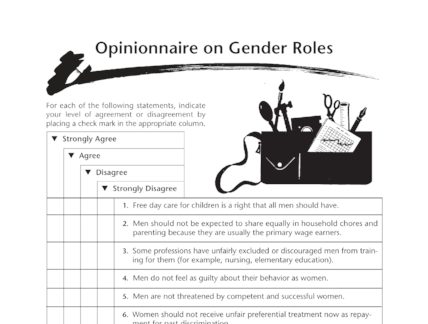
Document
Opinionnaire on Gender Roles (Part 2)
Students share their opinions in response to a series of statements about gender roles in society.
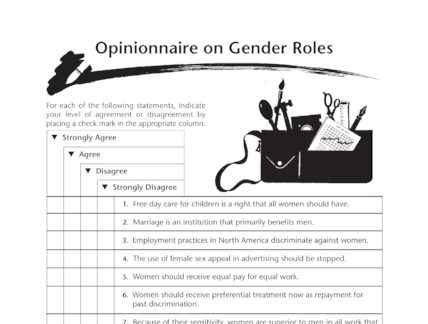
Document
Opinionnaire on Gender Roles (Part 1)
Students share their opinions in response to a series of statements about gender roles in society.
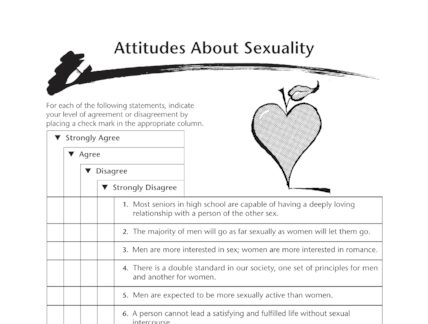
Document
Attitudes About Sexuality
This handout presents a series of statements about sexuality. Students are to indicate their level of agreement or disagreement with each.
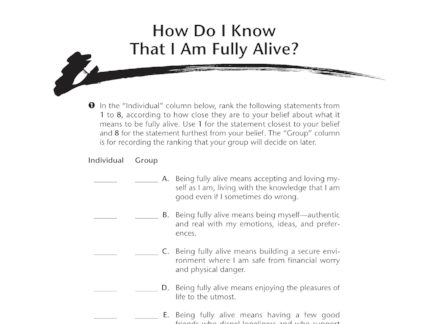
Document
How Do I Know That I Am Fully Alive?
This handout asks students to rank statements according to their beliefs about what it means to be fully alive.
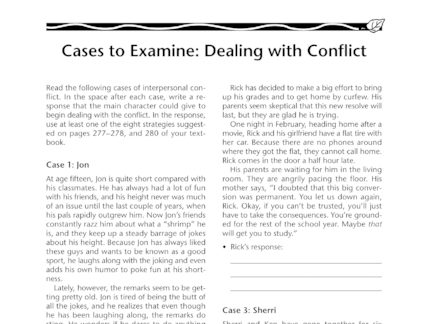
Document
Cases to Examine: Dealing with Conflict
This handout provides three situations for students to read and evaluate. Students must give a suggestion for how to respond to the conflict in each scenario based on the strategies in the book.
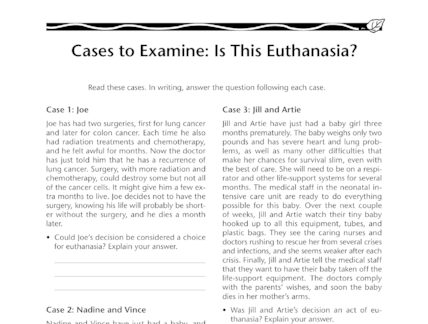
Document
Cases to Examine: Is This Euthanasia?
This handout provides three situations for students to read and evaluate. Students must decide if the story shows an example of Euthanasia.
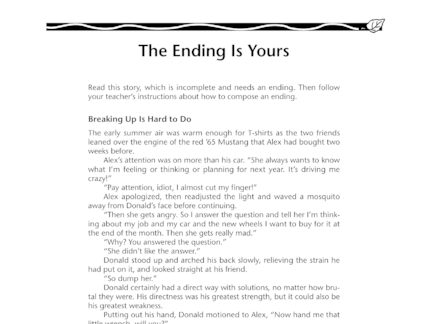
Document
The Ending is Yours
This handout provides the beginning of a story about a teen who is about to break up with his girlfriend. Students are to complete the story following teacher instructions.
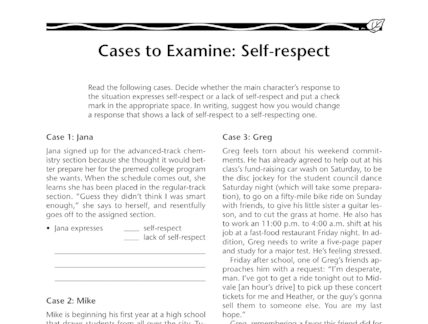
Document
Cases to Examine: Self-respect
This handout provides three situations where teenagers are not fully respecting themselves. Students read the situations and respond with suggestions that demonstrate more self-respect.

Document
Role-plays: Kindness and Truth
This handout provides two role-play situations for students to practice open, honest communication in a kind, truthful way.
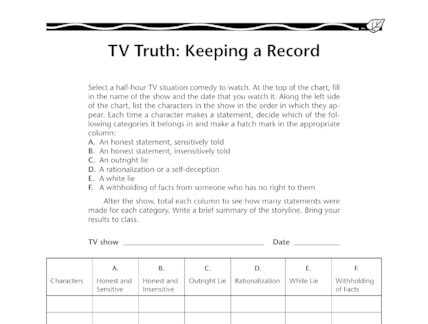
Document
TV Truth: Keeping a Record
This handout provides a chart to help students keep track of the types of truths and lies portrayed on TV.

Document
An Inventory on Money Matters
This handout provides a chart to help students keep track of their expenditures during one week

Document
Perspectives on Sex
This handout provides several comments from teenagers about sex. It can be used as a discussion starter or writing prompt.
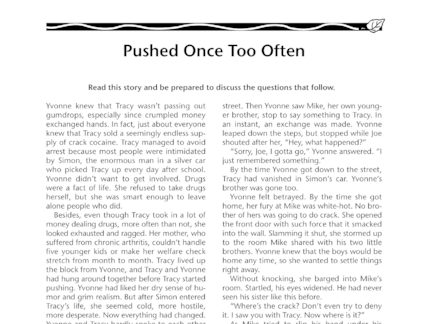
Document
Pushed Once Too Often
This handout presents a story about drug pushing in a school community. Students are challenged to reflect on several questions regarding the situation.
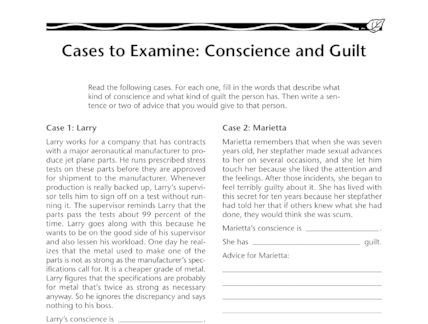
Document
Cases to Examine: Conscience and Guilt
Read the following cases. For each one, fill in the words that describe what kind of conscience and what kind of guilt the person has. Then write a sentence or two of advice that you would give to that person.

Document
The LISTEN Model
Briefly describe below a moral dilemma that an individual might face. For each section of the LISTEN process, fill in one or more things a person facing this dilemma might need to consider.
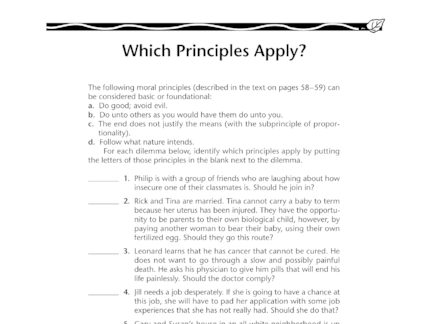
Document
Which Principles Apply?
he following moral principles (described in the text on pages 58–59) can be considered basic or foundational: a. Do good; avoid evil. b. Do unto others as you would have them do unto you. c. The end does not justify …

Document
Getting to Know My Parents' Views
This checklist will help you identify how well you understand your parents’ (or guardians’) views on moral issues and whether you think that your parents understand your views on moral issues.

Document
"O Lord, You Have Searched Me and Known Me"
Spend a few moments quietly asking God to help you see clearly and honestly into your heart and mind as you begin this examination of conscience. Write your responses to the questions below. No one will collect this handout.
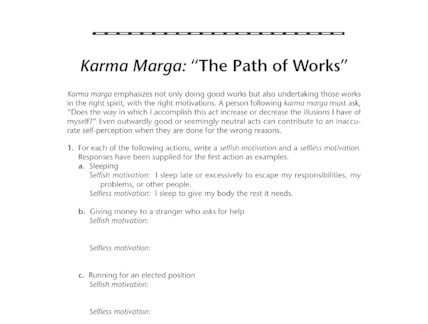
Document
Karma Marga: "The Path of Works"
For each of the following actions, write a selfish motivation and a selfless motivation. Responses have been supplied for the first action as examples.
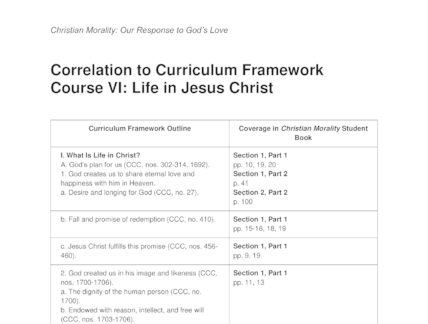
Document
Correlation to Curriculum Framework
Correlation to Curriculum Framework Course VI: Life in Jesus Christ from Christian Morality: Our Response to God’s Love.
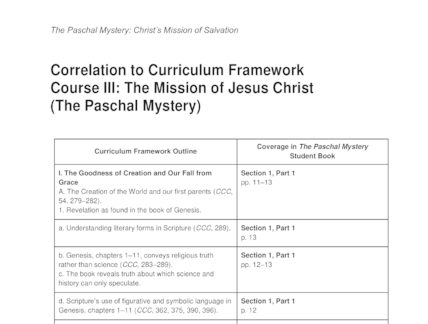
Document
Correlation to Curriculum Framework
Correlation to Curriculum Framework Course III: The Mission of Jesus Christ (The Paschal Mystery) from The Paschal Mystery: Christ’s Mission of Salvation.
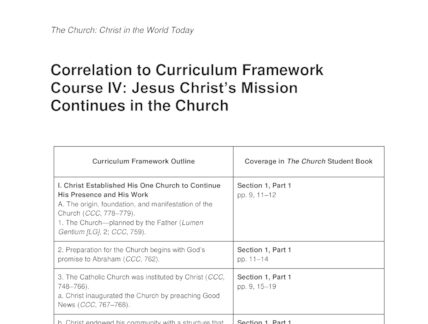
Document
Correlation to Curriculum Framework
Correlation to Curriculum Framework Course IV: Jesus Christ’s Mission Continues in the Church from The Church: Christ in the World Today.
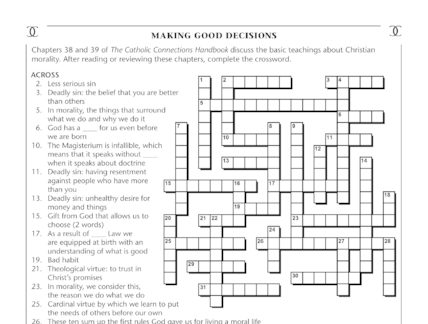
Document
Making Good Decisions
Chapters 38 and 39 of The Catholic Connections Handbook discuss the basic teachings about Christian morality. After reading or reviewing these chapters, complete the crossword.
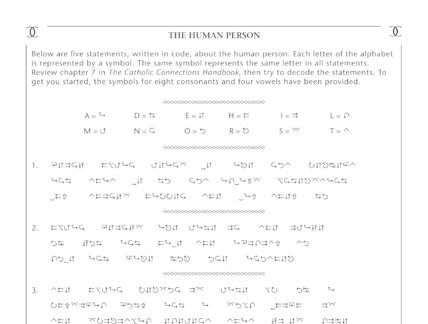
Document
The Human Person
Below are five statements, written in code, about the human person. Each letter of the alphabet is represented by a symbol. The same symbol represents the same letter in all statements. Review chapter 7 in The Catholic Connections Handbook, then …
Video
What is Catholic Social Teaching?
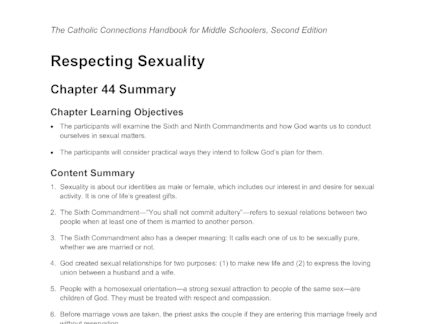
Document
Chapter 44 Summary: Respecting Sexuality
A nice summary of the Sixth and Ninth Commandments, and how God wants us to conduct ourselves in sexual matters.
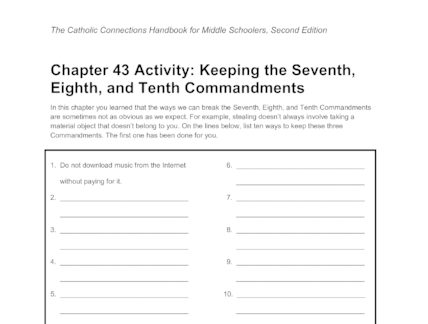
Document
Chapter 43 Activity: Keeping the Seventh, Eighth, and Tenth Commandments
Students are asked to list 10 practical ways to keep the 7th, 8th, and 10th Commandments.
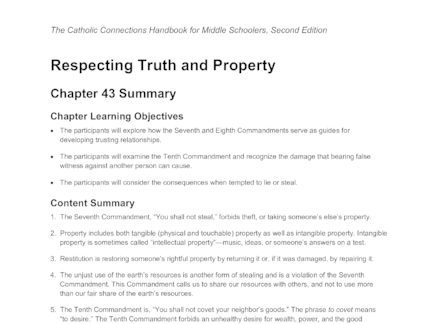
Document
Chapter 43 Summary: Respecting Truth and Property
A summary of Chapter 43, Respecting Truth and Property from the Catholic Connections Handbook for Middle Schoolers, Second Edition.
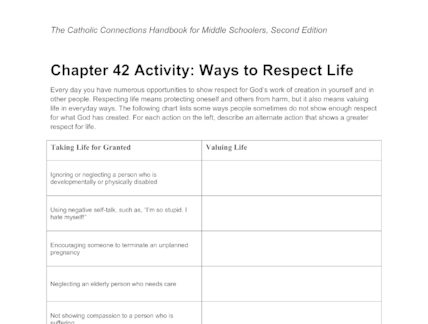
Document
Chapter 42 Activity: Ways to Respect Life
Every day you have numerous opportunities to show respect for God’s work of creation in yourself and in other people. Respecting life means protecting oneself and others from harm, but it also means valuing life in everyday ways. The following …
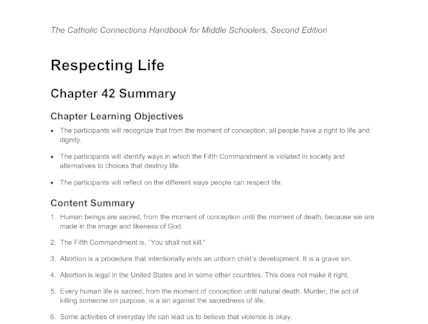
Document
Chapter 42 Summary: Respecting Life
A summary of Chapter 42, Respecting Life from the Catholic Connections Handbook for Middle Schoolers, Second Edition.
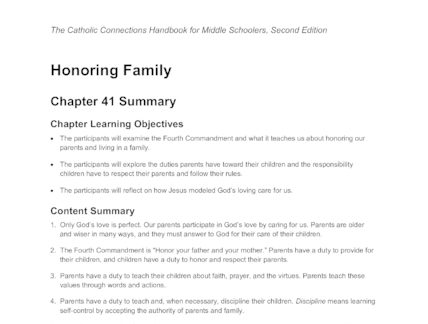
Document
Chapter 41 Summary: Honoring Family
A summary of Chapter 41, Honoring Family from the Catholic Connections Handbook for Middle Schoolers, Second Edition.
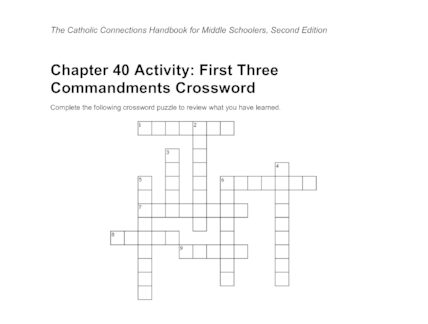
Document
Chapter 40 Activity: First Three Commandments Crossword
Complete the following crossword puzzle to review what you have learned.
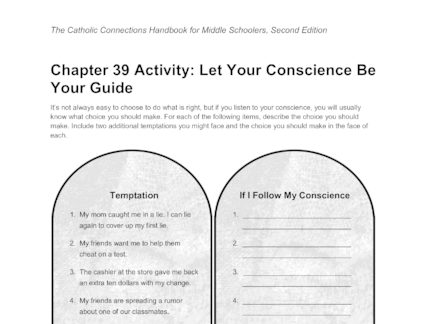
Document
Chapter 39 Activity: Let Your Conscience Be Your Guide
It’s not always easy to choose to do what is right, but if you listen to your conscience, you will usually know what choice you should make. For each of the following items, describe the choice you should make. Include …

Document
Chapter 39 Summary: Moral Decision Making
A summary of Chapter 39, Moral Decision Making from the Catholic Connections Handbook for Middle Schoolers, Second Edition.

Document
Chapter 38 Activity: How Do I Make Moral Decisions?
When you have a difficult moral decision to make, how do you go about figuring out what you should do? Do you talk with your friends or a parent or other adult, or do you pray about it? For some …
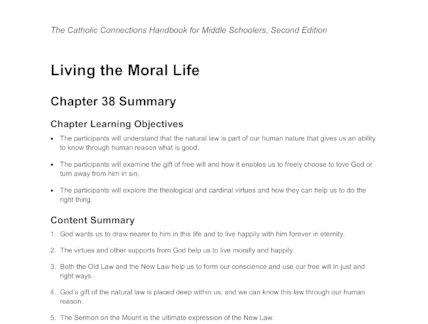
Document
Chapter 38 Summary: Living the Moral Life
A summary of Chapter 38, Living the Moral Life from the Catholic Connections Handbook for Middle Schoolers, Second Edition.
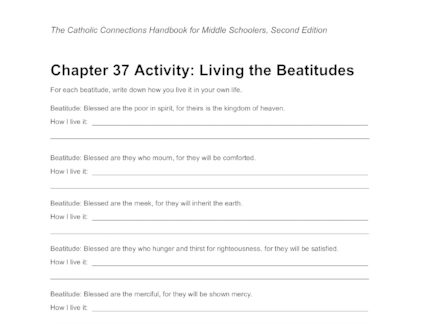
Document
Chapter 37 Activity: Living the Beatitudes
For each beatitude, write down how you live it in your own life.
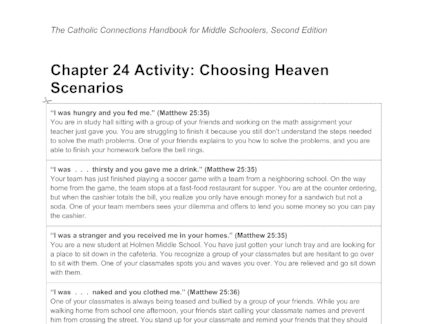
Document
Chapter 24 Activity: Choosing Heaven Scenarios
How to respond in various life issues situations.
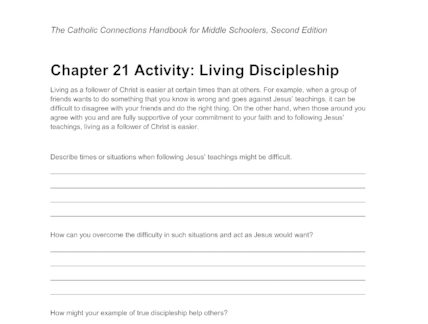
Document
Chapter 21 Activity: Living Discipleship
Living as a follower of Christ is easier at certain times than at others. For example, when a group of friends wants to do something that you know is wrong and goes against Jesus’ teachings, it can be difficult to …
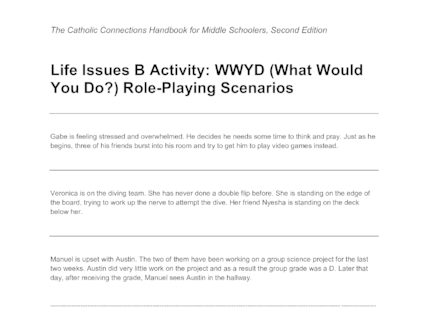
Document
Life Issues B Activity: WWYD (What Would You Do?) Role-Playing Scenarios
How you would respond to different life issue scenarios.
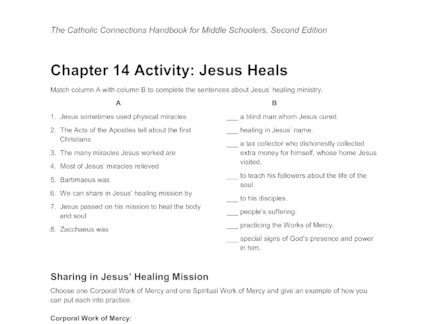
Document
Chapter 14 Activity: Jesus Heals
Match column A with column B to complete the sentences about Jesus’ healing ministry.
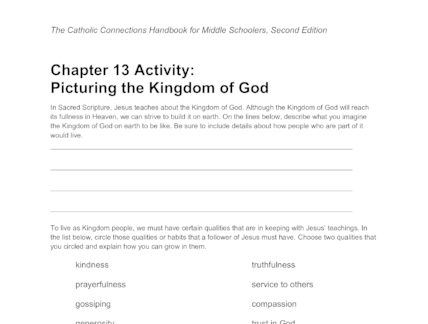
Document
Chapter 13 Activity: Picturing the Kingdom of God
In Sacred Scripture, Jesus teaches about the Kingdom of God. Although the Kingdom of God will reach its fullness in Heaven, we can strive to build it on earth. On the lines below, describe what you imagine the Kingdom of …
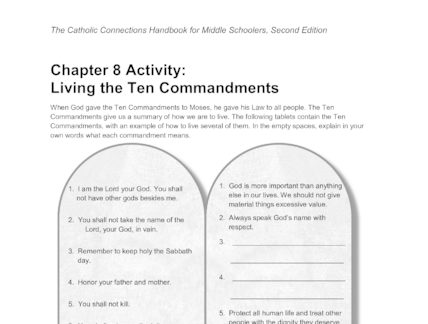
Document
Chapter 8 Activity: Living the Ten Commandments
When God gave the Ten Commandments to Moses, he gave his Law to all people. The Ten Commandments give us a summary of how we are to live. The following tablets contain the Ten Commandments, with an example of how …
Video
Celebrating Life: The Human Person and the Rules of God
Video
Bad News Becomes Good
Video
It's Never Too Late to Claim Chastity
Video
Obedience to God's Will: Our Greatest Happiness
Presentation
Chapter 32
A PowerPoint presentation with information from The Catholic Faith Handbook for Youth, Third Edition Chapter 32, The Moral Life.
Presentation
Chapter 31
A PowerPoint presentation with information from The Catholic Faith Handbook for Youth, Third Edition Chapter 31, Respecting Truth.
Presentation
Chapter 30
A PowerPoint presentation with information from The Catholic Faith Handbook for Youth, Third Edition Chapter 30, Respecting Material Goods.
Presentation
Chapter 29
A PowerPoint presentation with information from The Catholic Faith Handbook for Youth, Third Edition Chapter 29, Respecting Sexuality.
Presentation
Chapter 28: In-Depth
A PowerPoint presentation with information from The Catholic Faith Handbook for Youth, Third Edition Chapter 28, Life Issues: War.
Presentation
Chapter 27
A PowerPoint presentation with information from The Catholic Faith Handbook for Youth, Third Edition Chapter 27, Honoring Family.
Presentation
Chapter 25
A PowerPoint presentation with information from The Catholic Faith Handbook for Youth, Third Edition Chapter 25, Sources of Moral Truth.
Presentation
Chapter 23
A PowerPoint presentation with information from The Catholic Faith Handbook for Youth, Third Edition Chapter 23, Introduction to Christian Morality.
Presentation
Chapter 15
A PowerPoint on The Catholic Faith Handbook for Youth, Third Edition Chapter 15, The Last Things.
Presentation
Chapter 6
A PowerPoint on The Catholic Faith Handbook for Youth, Third Edition Chapter 6, The Human Person.
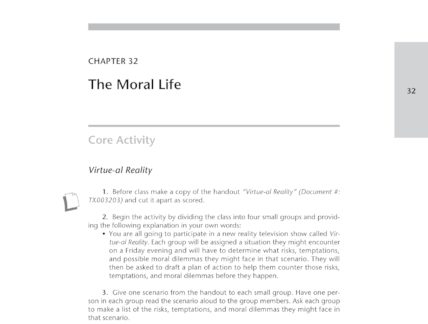
Document
Chapter 32 Activities
Activities for Chapter 32 The Moral Life including a core activity, core activity extension, and additional activities.
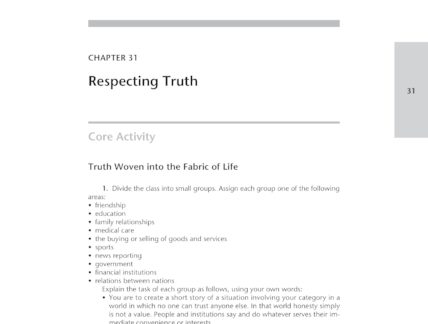
Document
Chapter 31 Activities
Activities for Chapter 31 Respecting Truth including a core activity, core activity extension, and additional activities.
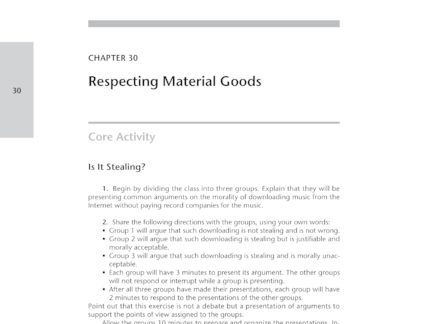
Document
Chapter 30 Activities
Activities for Chapter 30 Respecting Material Goods including a core activity, core activity extension, and additional activities.
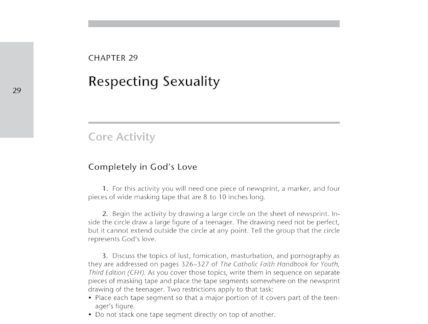
Document
Chapter 29 Activities
Activities for Chapter 29 Respecting Sexuality including a core activity, core activity extension, and additional activities.
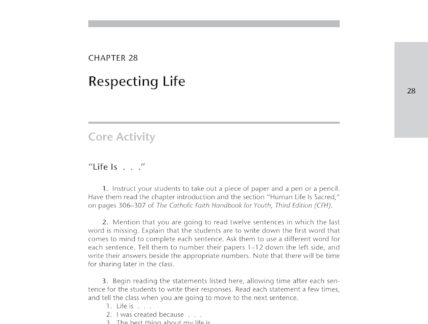
Document
Chapter 28 Activities
Activities for Chapter 28 Respecting Life including a core activity, core activity extension, and additional activities.
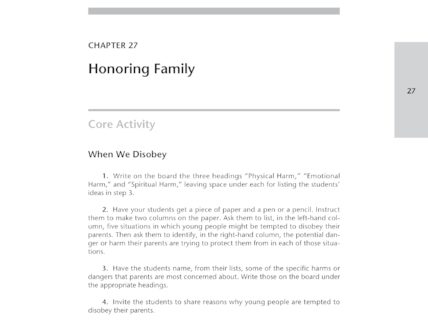
Document
Chapter 27 Activities
Activities for Chapter 27 Honoring Family including a core activity, core activity extension, and additional activities.
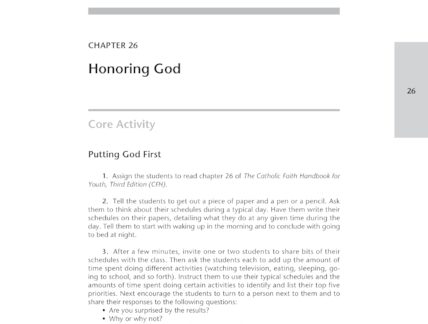
Document
Chapter 26 Activities
Activities for Chapter 26 Honoring God including a core activity, core activity extension, and additional activities.
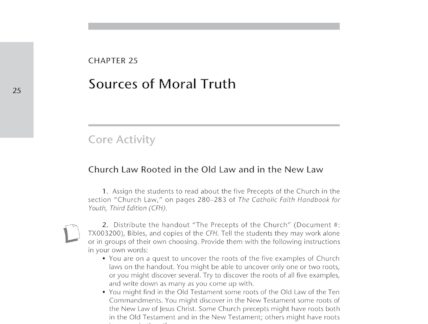
Document
Chapter 25 Activities
Activities for Chapter 25 Sources of Moral Truth including a core activity, core activity extension, and additional activities.
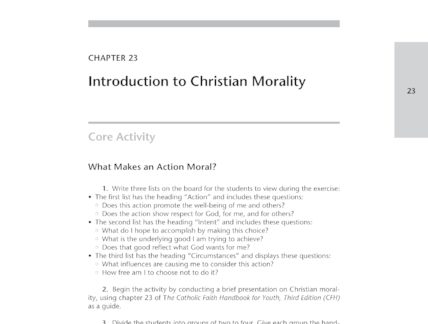
Document
Chapter 23 Activities
Activities for Chapter 23 Introduction to Christian Morality including a core activity, core activity extension, and additional activities.
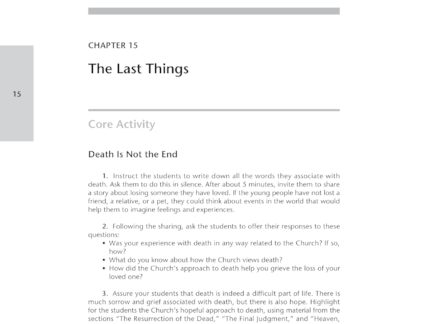
Document
Chapter 15 Activities
Activities for Chapter 15 The Last Things, including a core activity, core activity extension, and additional activities.
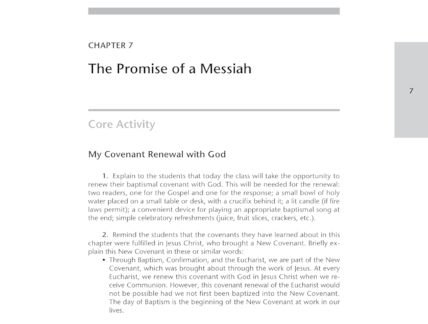
Document
Chapter 7 Activities
Activities for Chapter 7 The Promise of a Messiah, including a core activity, core activity extension, and additional activities.

Document
Chapter 6 Activities
Activities for Chapter 6 The Human Person, including a core activity, core activity extension, and additional activities.
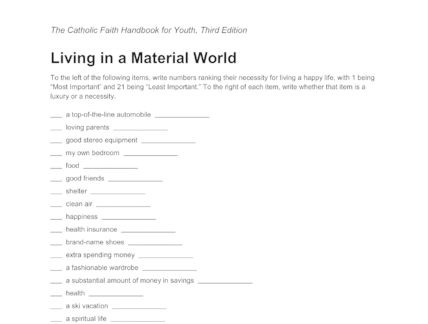
Document
Living in a Material World
A worksheet where students are asked to rank items on their necessity for living a happy life.
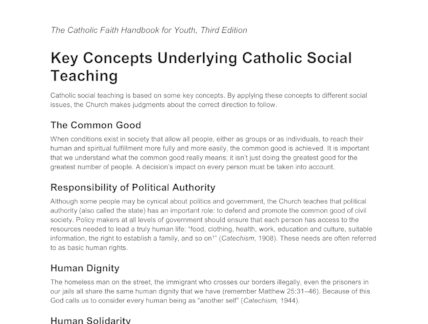
Document
Handout: Key Concepts Underlying Catholic Social Justice Teachings
Catholic social teaching is based on some key concepts. By applying these concepts to different social issues, the Church makes judgments about the correct direction to follow.
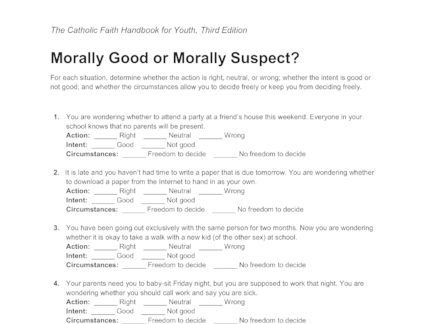
Document
Handout: Morally Good or Morally Suspect
For each situation, determine whether the action is right, neutral, or wrong; whether the intent is good or not good; and whether the circumstances allow you to decide freely or keep you from deciding freely.
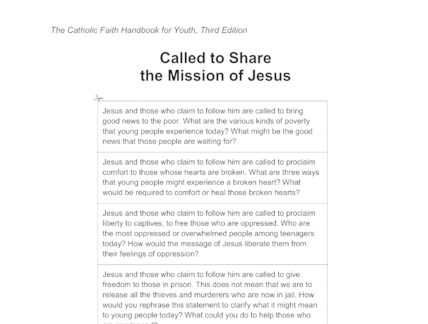
Document
Called to Share the Mission of Jesus
Questions about how we can imitate Jesus’ example in the way we interact with others.
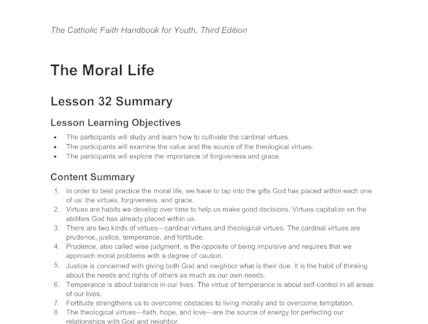
Document
Lesson 32 Summary
The lesson learning objectives and content summary for Lesson 32, The Moral Life.
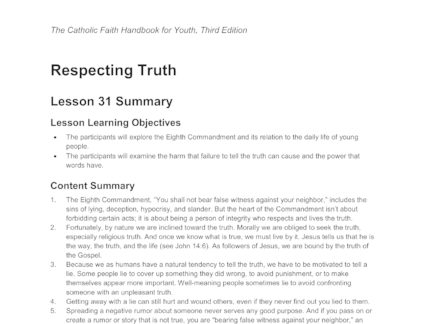
Document
Lesson 31 Summary
The lesson learning objectives and content summary for Lesson 31, Respecting Truth.

Document
Living in a Material World
Consider the following list of things. Which of them is necessary for you to have in order to be happy? Place a check mark in front of each one you feel is necessary.
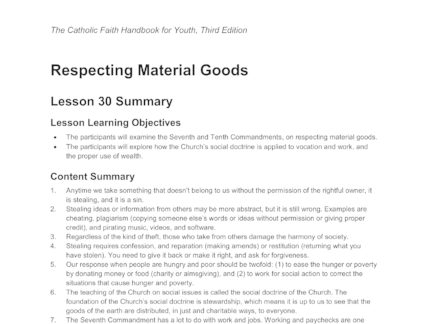
Document
Lesson 30 Summary
The lesson learning objectives and content summary for Lesson 30, Respecting Material Goods.
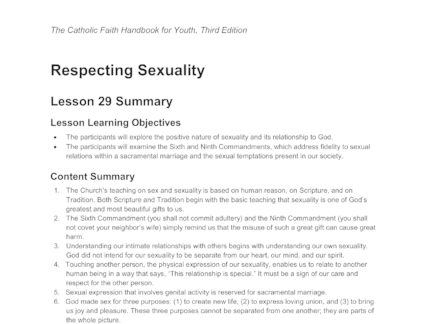
Document
Lesson 29 Summary
The lesson learning objectives and content summary for Lesson 29, Respecting Sexuality.
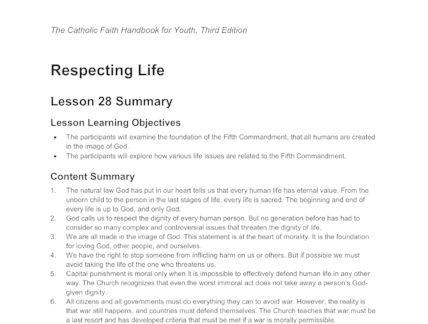
Document
Lesson 28 Summary
The lesson learning objectives and content summary for Lesson 28, Respecting Life.
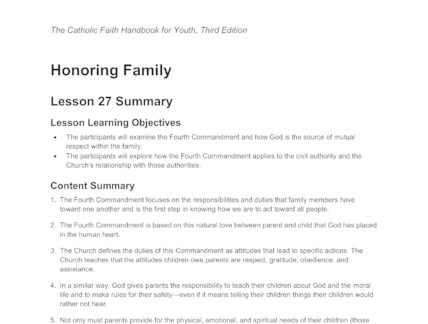
Document
Lesson 27 Summary
The lesson learning objectives and content summary for Lesson 27, Honoring God.
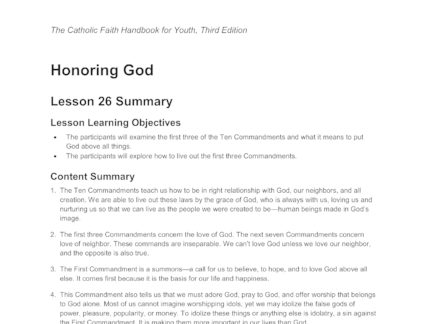
Document
Lesson 26 Summary
The lesson learning objectives and content summary for Lesson 26, Honoring God.
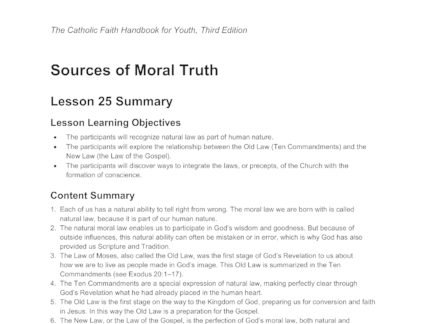
Document
Lesson 25 Summary
The lesson learning objectives and content summary for Lesson 25, Sources of Moral Truth.
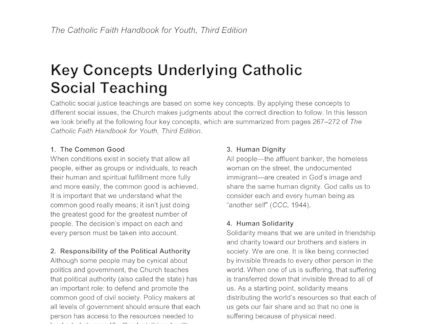
Document
Key Concepts Underlying Catholic Social Teaching
Catholic social justice teachings are based on some key concepts. By applying these concepts to different social issues, the Church makes judgments about the correct direction to follow. In this lesson we look briefly at the following four key concepts, …
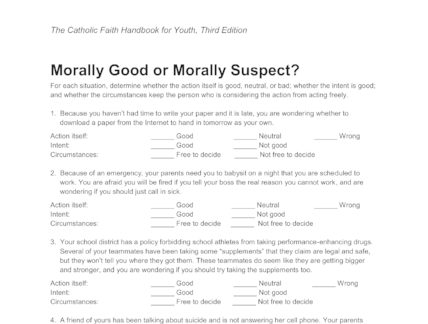
Document
Morally Good or Morally Suspect
For each situation, determine whether the action itself is good, neutral, or bad; whether the intent is good; and whether the circumstances keep the person who is considering the action from acting freely.

Document
Lesson 23 Summary
The lesson learning objectives and content summary for Lesson 23, Introduction to Christian Morality.

Document
A Living Sign of Hope
We believe that because we are transformed by faith in the Risen Jesus, his presence in the world becomes more visible through us. Read the following statements that are based on Jesus’ teachings, and then answer the questions that follow. …
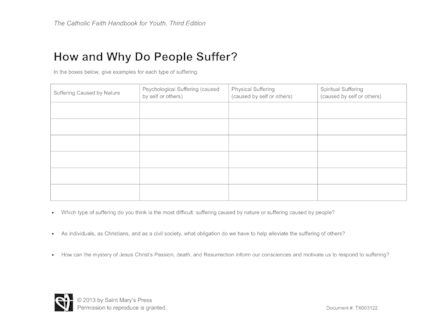
Document
How and Why Do People Suffer?
In the boxes below, give examples for each type of suffering, and respond to the questions that follow.

Document
Core Beliefs Practices and Attitudes of the Catholic Faith
Each statement below is a core belief of the Catholic faith. Choose a symbol (“I get it,” “I’m unsure,” or “I don’t get it”) that best reflects your understanding of each belief. Then briefly explain what you might know about …

Document
What Do I Know about the Catholic Faith
In the time allotted for this exercise, answer each question to the best of your knowledge. Each set of questions corresponds to the units you will study in this course and represents content you will cover in more detail in …
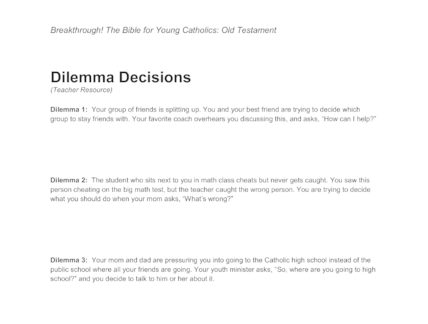
Document
Dilemma Decisions
A worksheet with tough decisions students may be faced with in their lives.
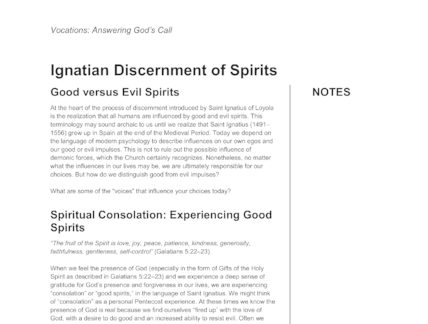
Document
Ignatian Discernment of Spirits
An article that breaks down the differences between good and evil spirits.
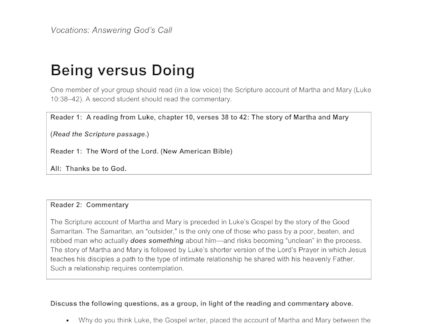
Document
Being versus Doing
A scripture passage from the Gospel of Luke about Martha and Mary is read along with a commentary, and is followed by large group discussion questions.
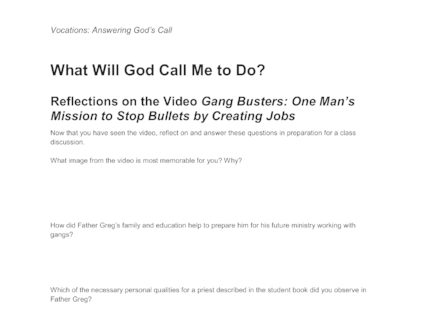
Document
What Will God Call Me to Do
A reflection worksheet and class discussion on the video Gang Busters: One Man’s Mission to Stop Bullets by Creating Jobs.
Presentation
Marriage: A Call to Fruitfulness
A PowerPoint about marriage, children, natural family planning, in vitro fertilization, and abortion.
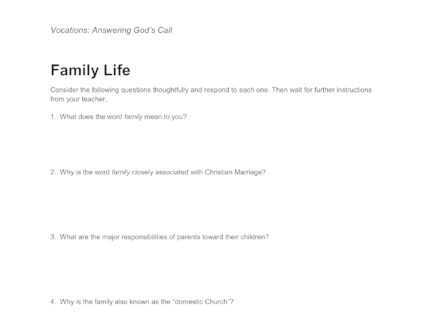
Document
Family Life
A worksheet with questions about the meaning of the family, the responsibilities of parents, the domestic Church, as well as the influence parents have on their children in their moral and spiritual development.
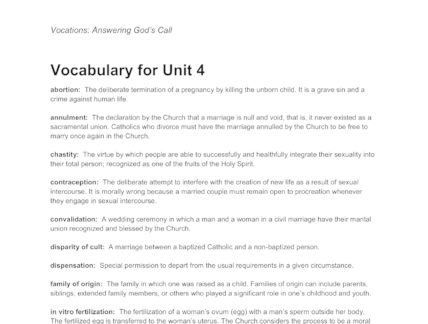
Document
Vocabulary for Unit 4
A vocabulary list from unit 4 that defines the words abortion, annulment, chastity, contraception, convalidation, disparity of a cult, dispensation, family of origin, in vitro fertilization, mixed marriage, and natural family planning.
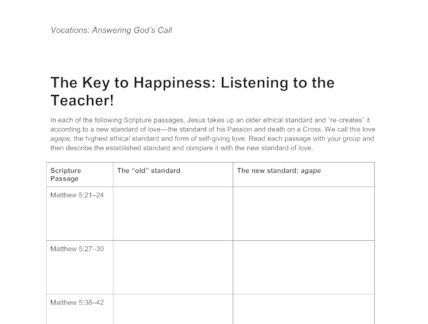
Document
The Key to Happiness: Listening to the Teacher!
An activity where groups of young people are asked to take a look at Scripture passages showing Jesus ”re-creating” an older ethical standard according to a new standard of love.
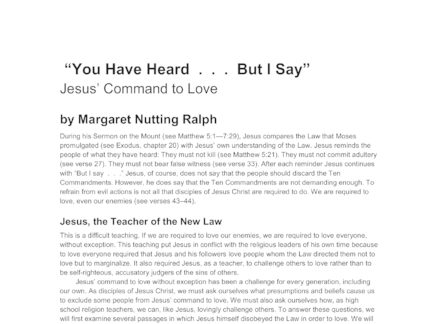
Document
"You Have Heard…But I Say"
An article about Jesus’ command to love everyone, even those who society has deemed unlovable.

Document
Living God's Call
A reading, with reflection questions, on living out God’s Call of unconditional love, agape, for all.
Video
The Violence of Capital Punishment
Presentation
The Fourth Commandment and the Decalogue
A PowerPoint presentation on the Fourth Commandment and the Decalogue.
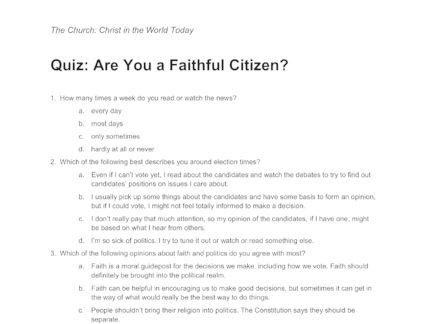
Document
Quiz: Are You a Faithful Citizen?
A self-quiz, or self-assessment, on faithful citizenship.
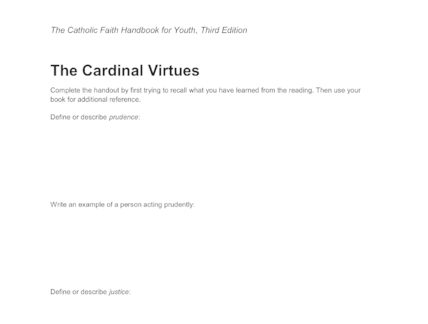
Document
The Cardinal Virtues
A handout on defining the Cardinal Virtues and describing how a person who exhibits the Cardinal Virtues acts.
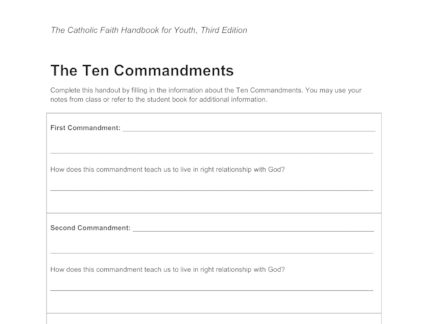
Document
The Ten Commandments
A worksheet focused on what the Ten Commandments teach us about living in right relationship with God and with our neighbors.
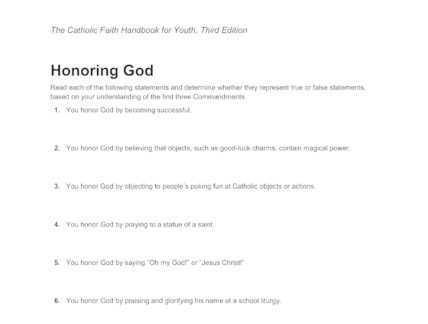
Document
Honoring God
A worksheet on honoring God based on students’ knowledge of the first three Commandments.
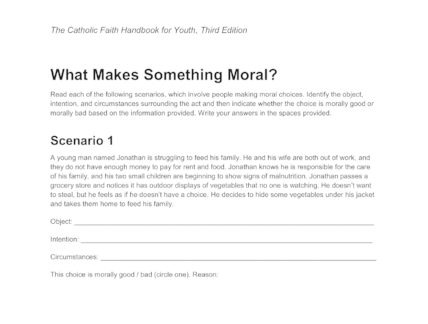
Document
What Makes Something Moral?
Two scenarios that involve people making moral choices. Students are asked to identify the object, intention, and circumstances surrounding the act in the scenario and indicate whether the choice is morally good or morally bad.
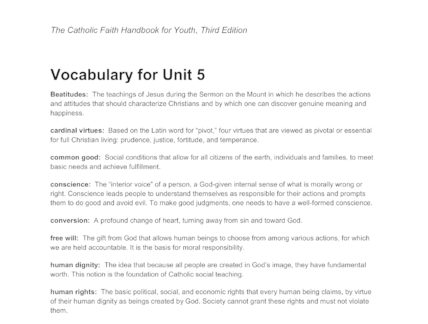
Document
Vocabulary for Unit 5
A list of vocabulary terms and definitions for Unit 5 of The Catholic Faith Handbook for Youth, Third Edition.
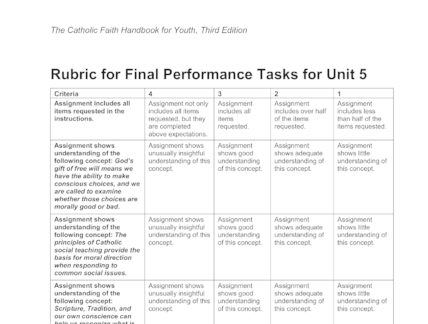
Document
Rubric for Final Performance Tasks for Unit 5
A grading rubric for the final performance task project options for Unit 5 of The Catholic Faith Handbook for Youth, Third Edition.
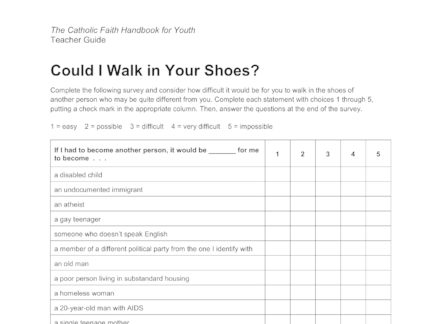
Document
Could I Walk in Your Shoes?
A survey that will help students consider how difficult it might be to walk in the shoes of another person who may be quite different from them.
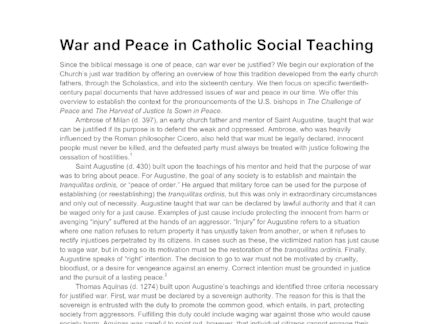
Document
War and Peace in Catholic Social Teaching
An article on war and peace in Catholic social teaching.
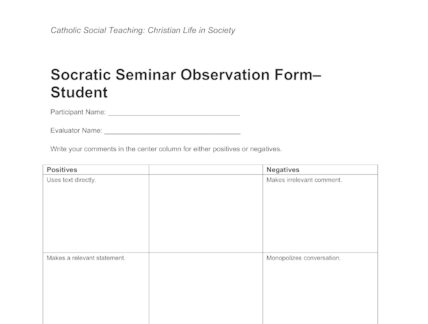
Document
Socratic Seminar Observation Form - Student
A student observation form for the Socratic seminar.

Document
Student Evaluation of the Socratic Seminar
A student evaluation sheet for the Socratic seminar.
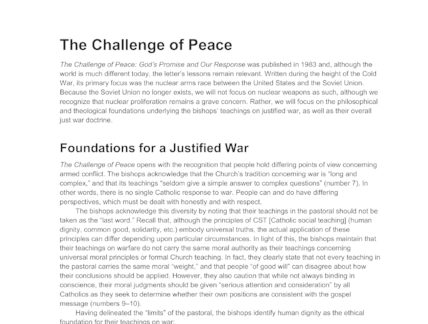
Document
The Challenge of Peace
An article on the foundations for a justified war and the just war doctrine.
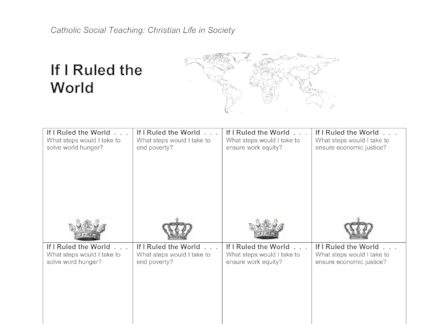
Document
If I Ruled the World
A worksheet that asks students to think about how they would solve different social justice issues if they ruled the world.
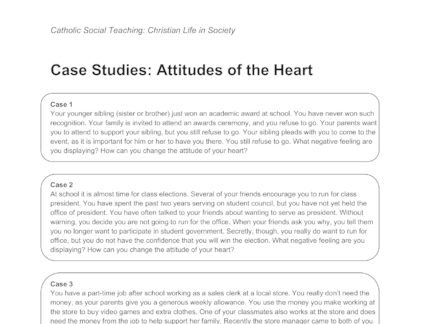
Document
Case Studies: Attitudes of the Heart
Several different scenarios are listed where negative feelings are displayed, and the question “how can you change the attitude of your heart?” is posed.
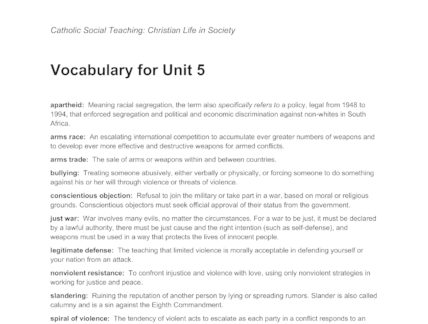
Document
Vocabulary for Unit 5 of “Catholic Social Teaching: Christian Life in Society.”
A list of several vocabulary terms and definition for Unit 5 of “Catholic Social Teaching: Christian Life in Society.”
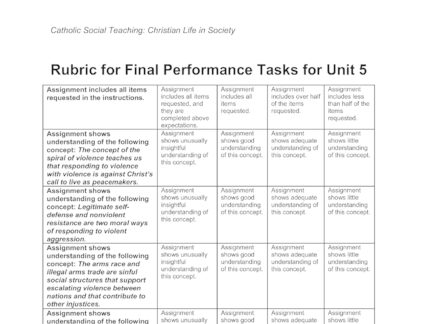
Document
Rubric for Final Performance Tasks for Unit 5 of “Catholic Social Teaching: Christian Life in Society.”
A grading rubric for the final performance task options for Unit 5 of “Catholic Social Teaching: Christian Life in Society.”
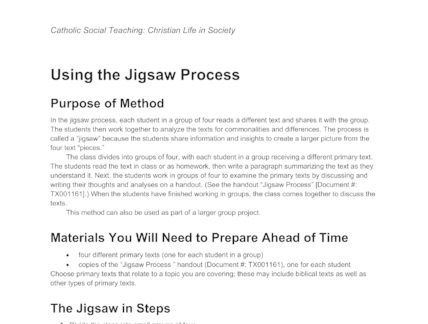
Document
Using the Jigsaw Process
A resource on how to use the jigsaw process, with is a method where students share information and insights from different readings to create a larger picture.
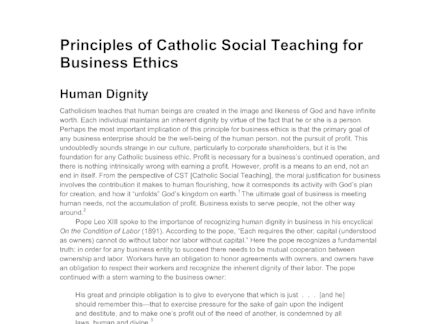
Document
Principles of Catholic Social Teaching for Business Ethics
An article on the principles of Catholic social teaching for business ethics.
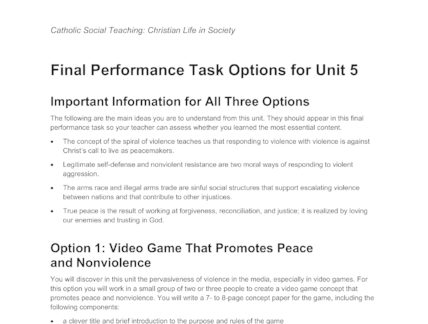
Document
Final Performance Task Options for Unit 5 of “Catholic Social Teaching: Christian Life in Society.”
A list of several final performance task options for Unit 5 of “Catholic Social Teaching: Christian Life in Society.”
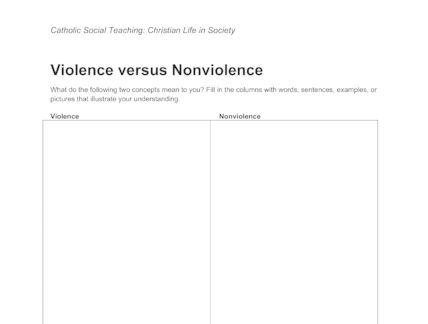
Document
Violence versus Nonviolence
A worksheet where students fill in what they know and understand about violence and nonviolence.
Presentation
Respecting Human Life and Dignity
A PowerPoint presentation on respecting human life and dignity.
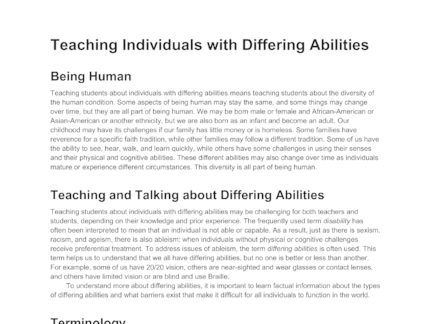
Document
Teaching Individuals with Differing Abilities
A reading on teaching and talking to students about differing abilities, along with several reinforcing activity ideas.
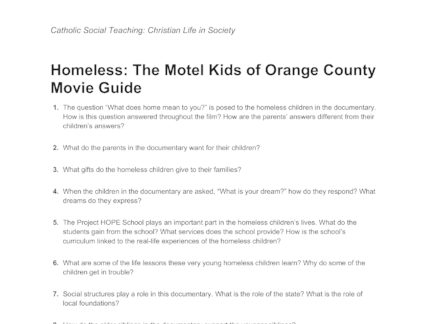
Document
"Homeless: Motel Kids of Orange County" Movie Guide
A movie guide with questions pertaining to the film “Homeless: The Motel Kids of Orange County.”
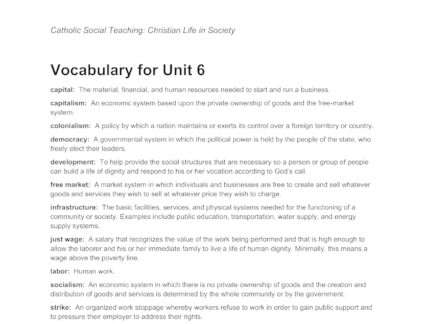
Document
Vocabulary for Unit 6 of “Catholic Social Teaching: Christian Life in Society.”
A list of vocabulary terms for Unit 6 of “Catholic Social Teaching: Christian Life in Society.”
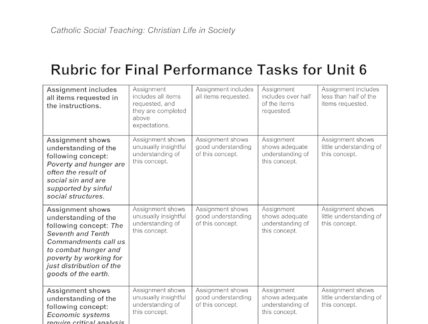
Document
Rubric for Final Performance Tasks for Unit 6 of “Catholic Social Teaching: Christian Life in Society.”
A grading rubric for the final performance task options for Unit 6 of “Catholic Social Teaching: Christian Life in Society.”
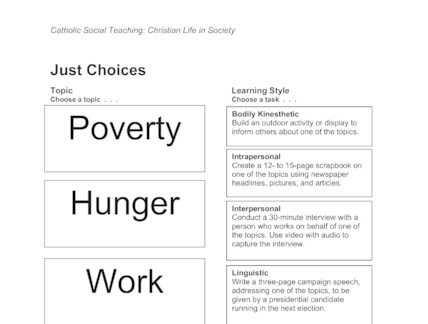
Document
Just Choices
A worksheet on just choices where students choose a topic to cover as well as a task based on their preferred learning style.
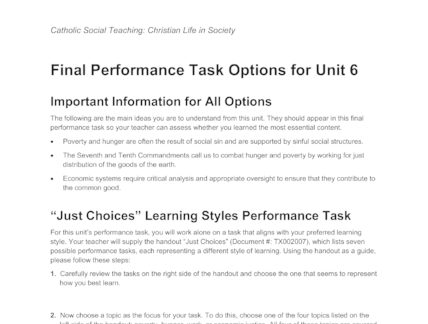
Document
Final Performance Task Options for Unit 6 of “Catholic Social Teaching: Christian Life in Society.”
A list of several final performance task options for Unit 6 of “Catholic Social Teaching: Christian Life in Society.”
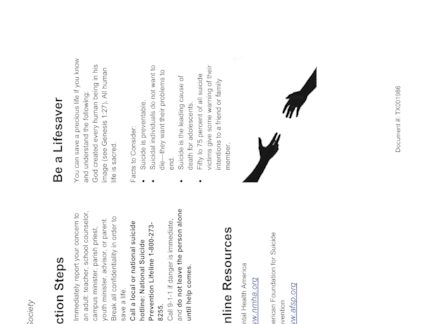
Document
Suicide Prevention
A document on suicide prevention including warning signs, action steps, online resources, and lifesaving facts to consider.
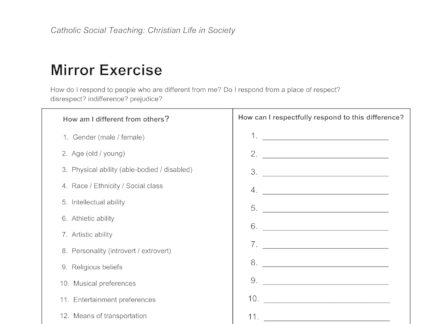
Document
Mirror Exercise
An exercise that encourages students to reflect on how they are different from others, and how they can respectfully respond to these differences.
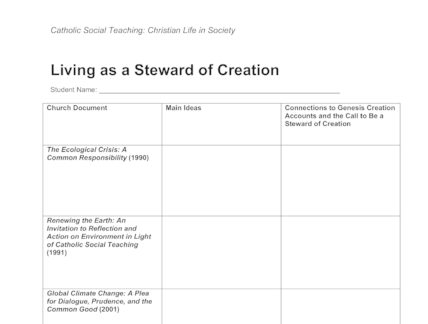
Document
Living As a Steward of Creation
An activity where students decipher the main ideas of several Church documents, and then make connections to Genesis creations accounts and the call to be stewards of creation.
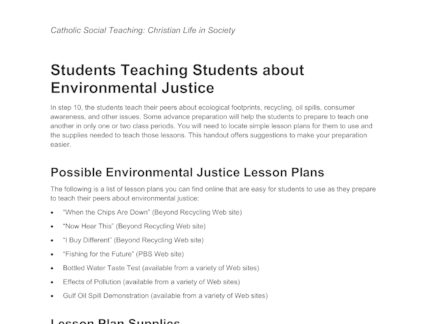
Document
Students Teaching Students About Environmental Justice
A lesson plan entitled “Students Teaching Students about Environmental Justice.”
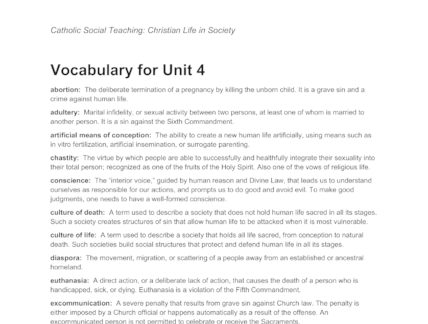
Document
Vocabulary for Unit 4 of “Catholic Social Teaching: Christian Life in Society.”
A list of vocabulary terms for Unit 4 of “Catholic Social Teaching: Christian Life in Society.”
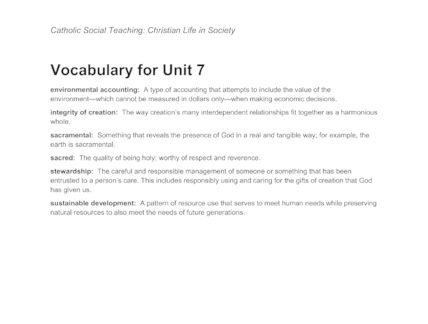
Document
Vocabulary for Unit 7 of “Catholic Social Teaching: Christian Life in Society.”
A list of vocabulary terms for Unit 7 of “Catholic Social Teaching: Christian Life in Society.”
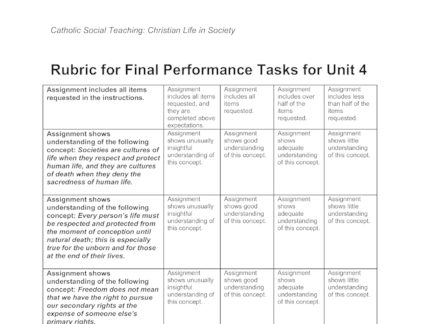
Document
Rubric for Final Performance Tasks for Unit 4 of “Catholic Social Teaching: Christian Life in Society.”
A grading rubric for several final performance task options for Unit 4 of “Catholic Social Teaching: Christian Life in Society.”
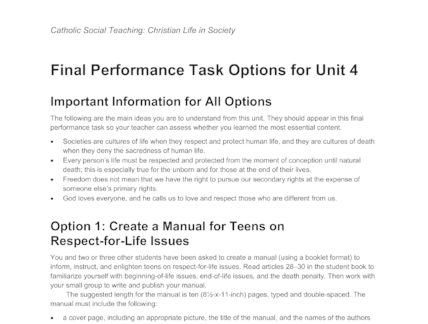
Document
Final Performance Task Options for Unit 4
A list of several final performance task options for Unit 4 of "Catholic Social Teaching: Christian Life in Society."
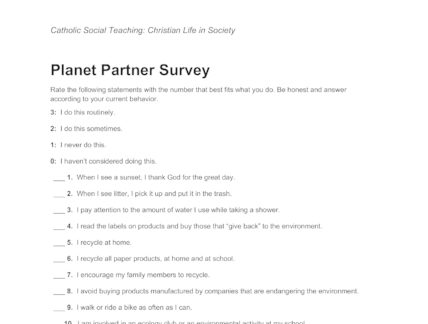
Document
Planet Partner Survey
A self-assessment survey on how well students are stewards of creation.
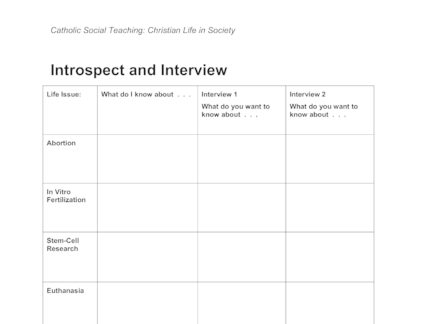
Document
Introspect and Interview
A worksheet on introspect and knowledge gained from interviews on important life issues including abortion, in vitro fertilization, stem-cell research, euthanasia, the death penalty, and immigration.
Presentation
Commitment to the First Commandment
A PowerPoint presentation on commitment to the First Commandment.
Presentation
God's Plan
A PowerPoint presentation on "God's Plan" from "Christian Morality, Our Response to God's Love."

Document
The Fourth Commandment
An excerpt from Pope John Paul II's letter to families in 1994, the Year of the Family, dealing with the fourth commandment.
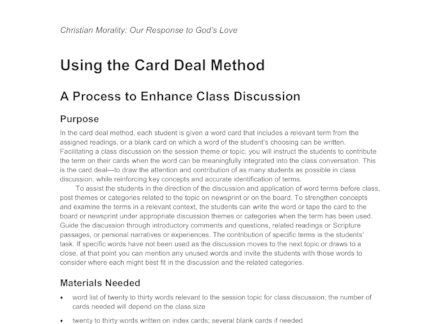
Document
Using the Card Deal Method
An instructional guide for using the card deal method, from "Christian Morality: Our Response to God's Love."

Document
Premarital Sex
An article on premarital sex, from "Christian Morality: Our Response to God's Love."
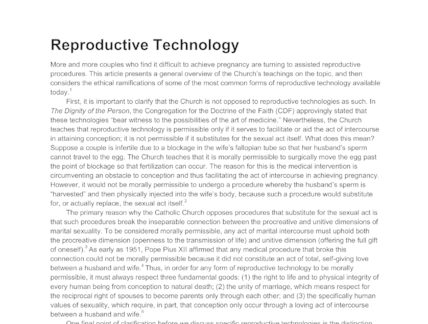
Document
Reproductive Technology
This article presents a general overview of the Church’s teachings on reproductive technology, and then considers the ethical ramifications of some of the most common forms of reproductive technology available today.
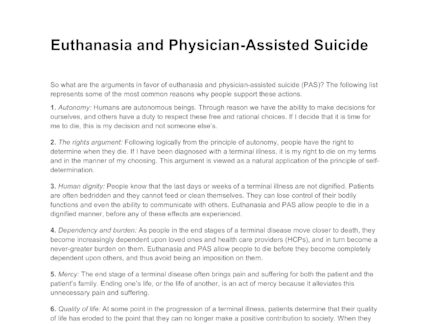
Document
Euthanasia and Physician Assisted Suicide
An article on euthanasia and physician assisted suicide, from "Christian Morality: Our Response to God's Love."
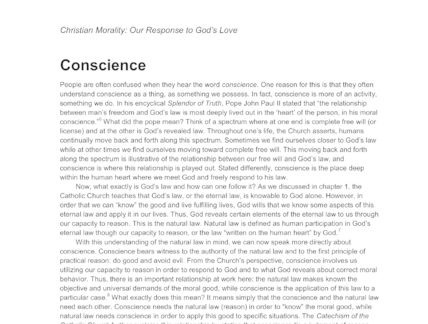
Document
Conscience
An article on conscience, from "Christian Morality: Our Response to God's Love."
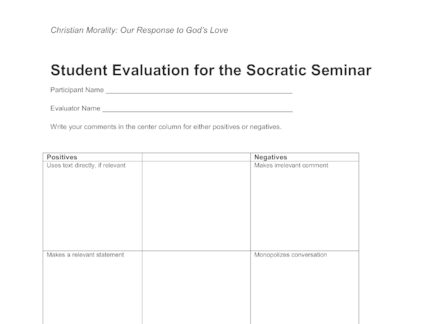
Document
Student Evaluation of the Socratic Seminar
A student evaluation form for the Socratic seminar.
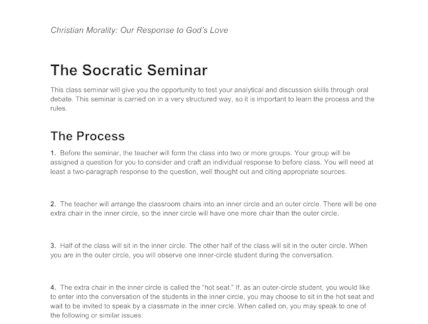
Document
The Socratic Seminar
This class seminar will give you the opportunity to test your analytical and discussion skills through oral debate. This seminar is carried on in a very structured way, so it is important to learn the process and the rules.
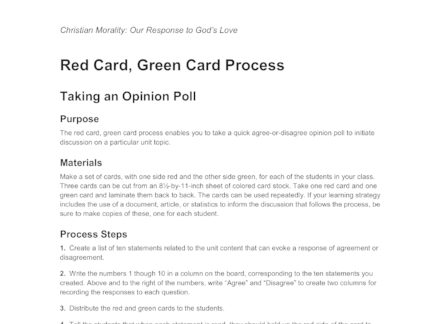
Document
Red Card Green Card Process
The red card, green card process enables you to take a quick agree-or-disagree opinion poll to initiate discussion on a particular unit topic.
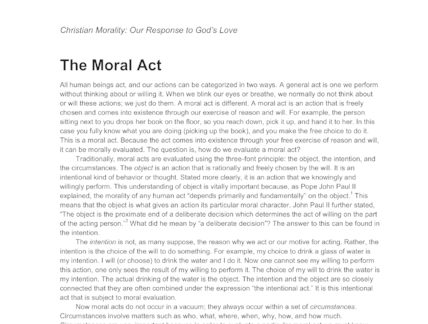
Document
The Moral Act
An excerpt on moral acts from "Christian Morality: Our Response to God's Love."
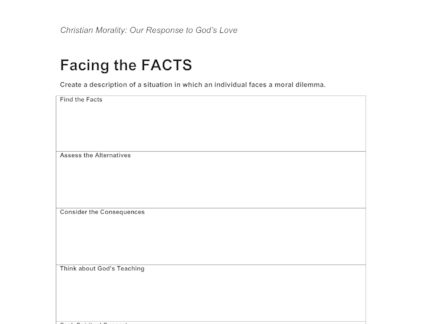
Document
Facing the FACTS
An activity on the FACTS decision-making process used when faced with a moral dilemma.
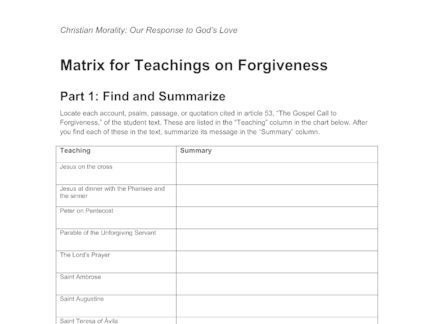
Document
Matrix for Teachings on Forgiveness
A matrix activity for teachings on forgiveness, from "Christian Morality: Our Response to God's Love."
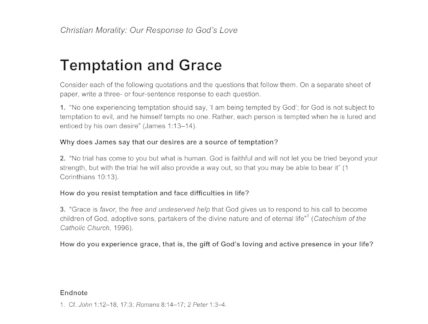
Document
Temptations and Grace
Quotations and questions dealing with temptations and grace, from "Christian Morality: Our Response to God's Love."
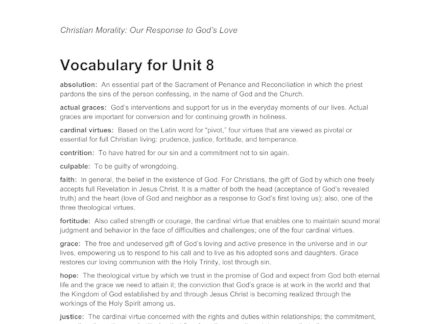
Document
Vocabulary for Unit 8
Vocabulary terms for Unit 8 of "Christian Morality: Our Response to God's Love."
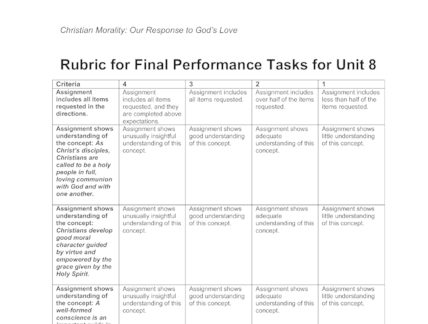
Document
Rubric for Final Performance Tasks for Unit 8
A rubric for final performance tasks for Unit 8 of "Christian Morality: Our Response to God's Love."
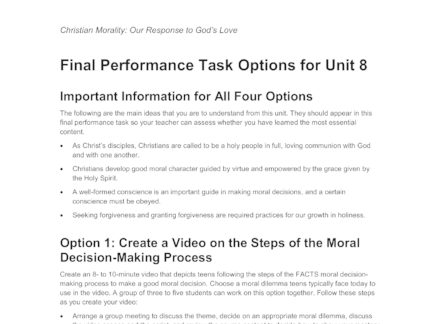
Document
Final Performance Task Options for Unit 8
Several performance task options for Unit 8 of "Christian Morality: Our Response to God's Love."
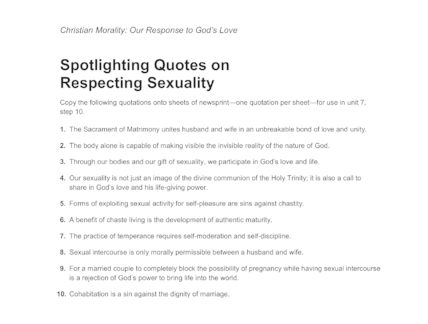
Document
Spotlighting Quotes on Respecting Sexualtity
Quotes on respecting sexuality, from "Christian Morality: Our Response to God's Love."
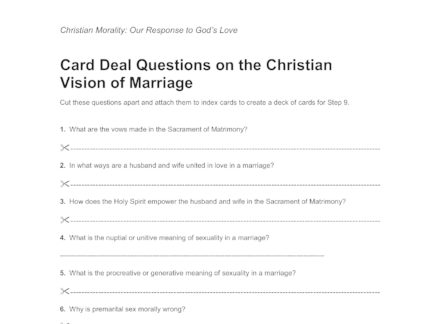
Document
Card Deal Questions on the Christian Vision of Marriage
An activity dealing with index cards from "Christian Morality: Our Response to God's Love."
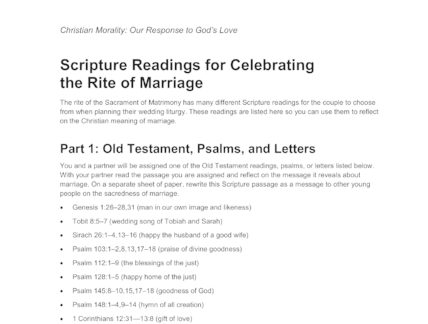
Document
Scripture Readings for Celebrating the Rite of Marriage
A list of Scripture readings that can be included in celebrating the Rite of Marriage, from "Christian Morality: Our Response to God's Love."
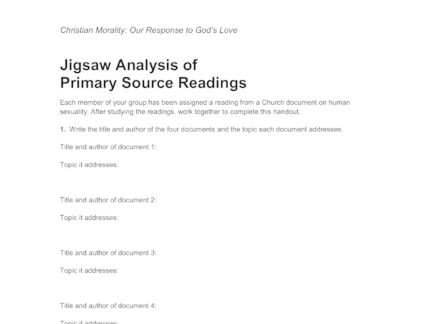
Document
Jigsaw Analysis of Primary Source Readings
A group activity dealing with the concept of human sexuality, from "Christian Morality: Our Response to God's Love."
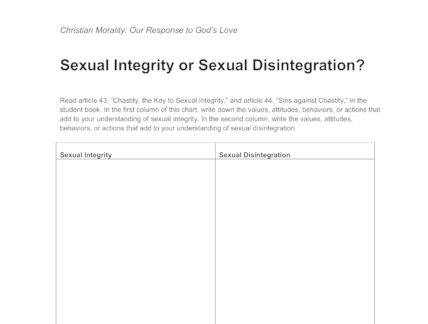
Document
Sexual Integrity or Sexual Disintegration
A worksheet dealing the with concepts of sexual integrity and sexual disintegration, from "Christian Morality: Our Response to God's Love."
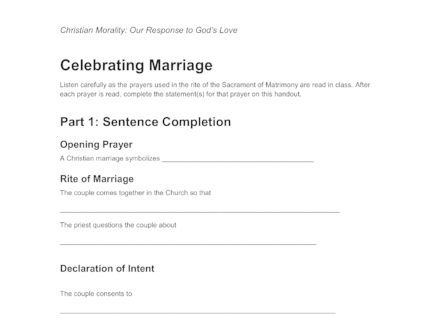
Document
Celebrating Marriage
A worksheet dealing with the rite of the Sacrament of Matrimony, from "Christian Morality: Our Response to God's Love."
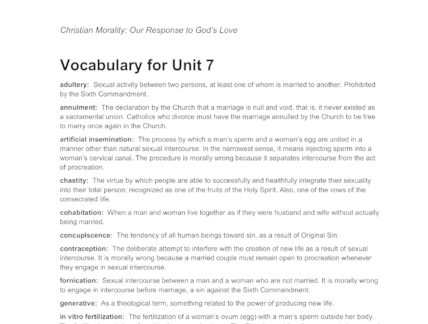
Document
Vocabulary for Unit 7
Vocabulary terms for Unit 7 of "Christian Morality: Our Response to God's Love."
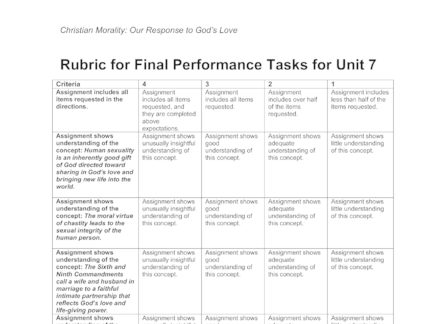
Document
Rubric for Final Performance Tasks for Unit 7
A rubric for final performance tasks for Unit 7 of "Christian Morality: Our Response to God's Love."
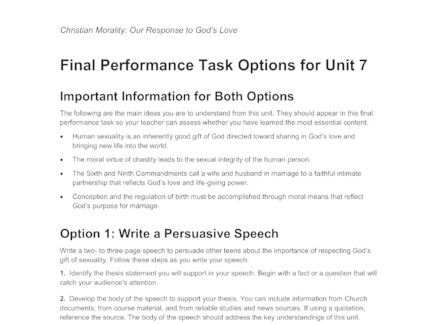
Document
Final Performace Task for Unit 7
Several final performance task options for Unit 7 of "Christian Morality: Our Response to God's Love."
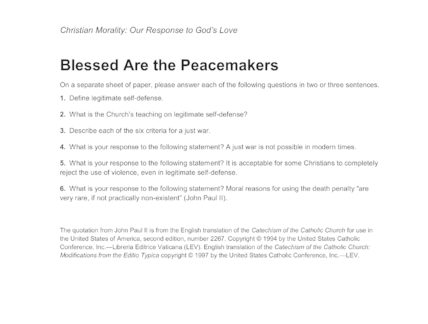
Document
Blessed Are the Peacemakers
A worksheet with short answer questions, from "Christian Morality: Our Response to God's Love."
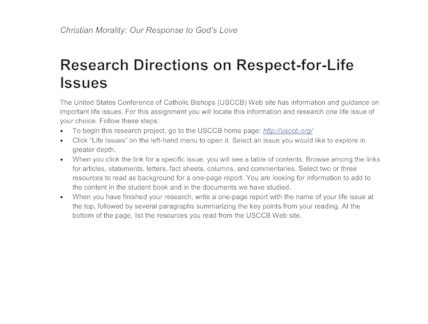
Document
Research Directions on Respect for Life Issues
Directions to research respect for life issues, from "Christian Morality: Our Response to God's Love."
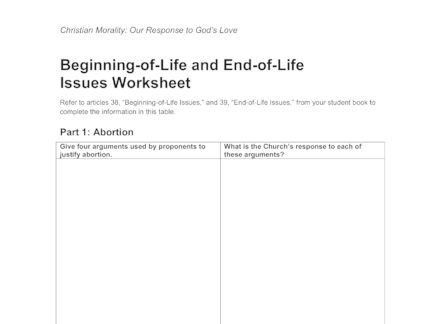
Document
Beginning of Life and End of Life Issues Worksheet
A worksheet on beginning of life and end of life issues, from "Christian Morality: Our Response to God's Love."

Document
Vocabulary for Unit 6
Vocabulary terms for Unit 6 of "Christian Morality: Our Response to God's Love."

Document
Rubric for Final Performance Tasks for Unit 6
A rubric for final performance tasks from Unit 6 of "Christian Morality: Our Response to God's Love."
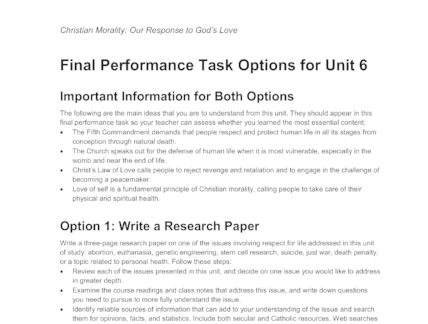
Document
Final Performance Task Options for Unit 6
Options for final performance tasks for Unit 6 of "Christian Morality: Our Response to God's Love."
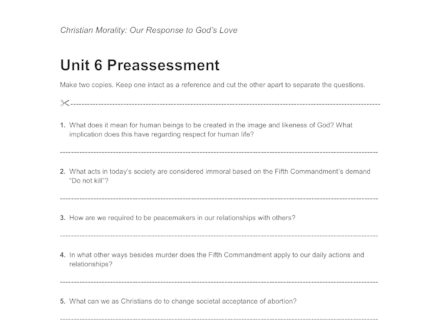
Document
Unit 6 Preassessment Questions
A preassessment for Unit 6 of "Christian Morality: Our Response to God's Love."

Document
The Strengths of Catholic Social Teaching
A document highlighting the strengths of Catholic Social Teaching, from "Christian Morality: Our Response to God's Love."
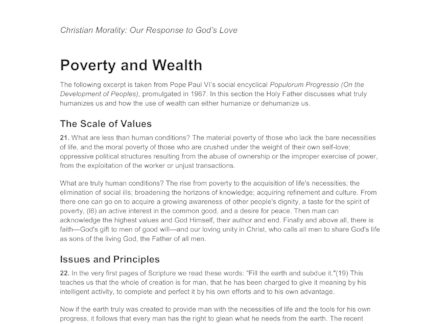
Document
Poverty and Wealth
An excerpt on poverty and wealth from "Christian Morality: Our Response to God's Love."
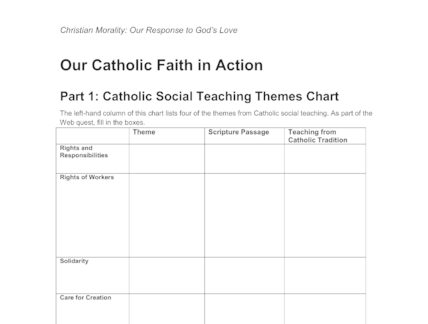
Document
Our Catholic Faith in Action
A chart that accompanies the Web Quest on our Catholic faith in action, from "Christian Morality: Our Response to God's Love."
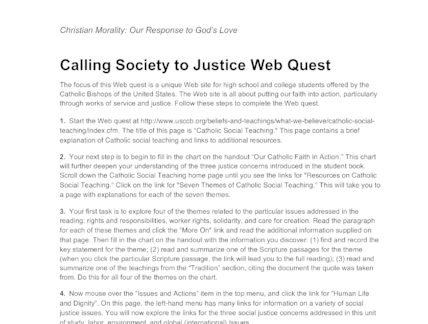
Document
Calling Society to Justice Web Quest
A Web Quest dealing with calling society to justice, from "Christian Morality: Our Response to Gods Love."
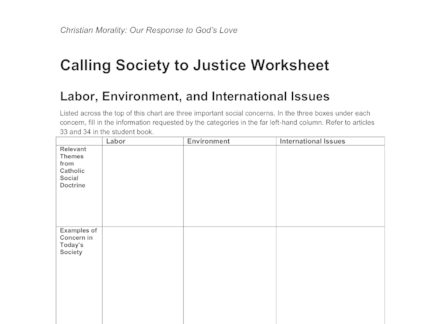
Document
Calling Society to Justice Worksheet
A worksheet on calling society to justice, from "Christian Morality: Our Response to God's Love."

Document
Vocabulary for Unit 5
A vocabulary list for Unit 5 of "Christian Morality: Our Response to God's Love."
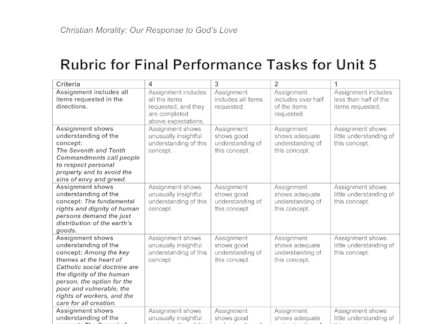
Document
Rubric for Final Performance Tasks for Unit 5
A rubric for the final performance task options for Unit 5 of "Christian Morality: Our Response to God's Love."
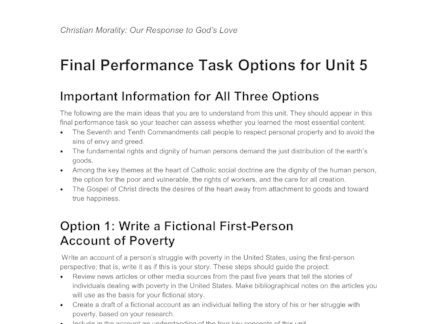
Document
Final Performace Task Options for Unit 5
Several final performance task options for Unit 5 of "Christian Morality: Our Response to God's Love."

Document
Martyrs in the Twentieth Century
A group discussion sheet on martyrs in the twentieth century, from "Christian Morality: Our Response to God's Love."
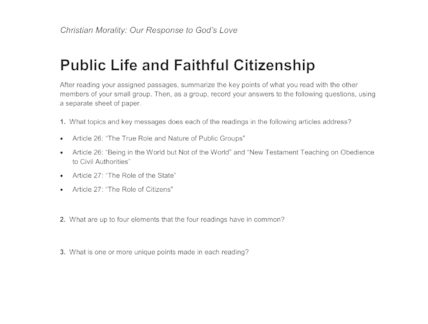
Document
Public Life and Faithful Citizenship
Group discussion questions, based on a reading assignment, on public life and faithful citizenship, from "Christian Morality: Our Response to God's Love."
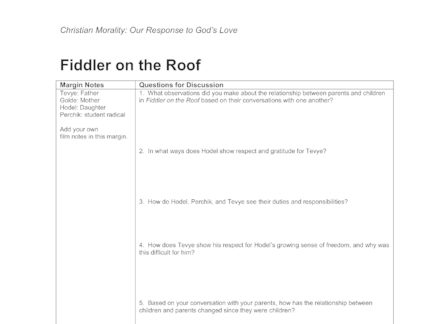
Document
Fiddler on the Roof
Questions for discussion for "Fiddler on the Roof" from "Christian Morality: Our Response to God's Love."
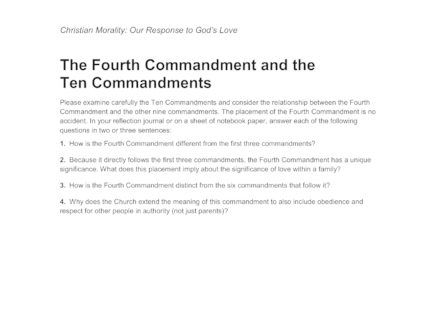
Document
The Fourth Commandment and The Ten Commandments
A worksheet regarding the Ten Commandments, especially the Fourth Commandment, from "Christian Morality: Our Response to God's Love."
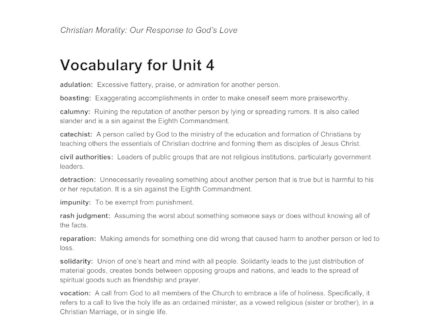
Document
Vocabulary for Unit 4
A vocabulary sheet for Unit 4 of "Christian Morality: Our Response to God's Love."
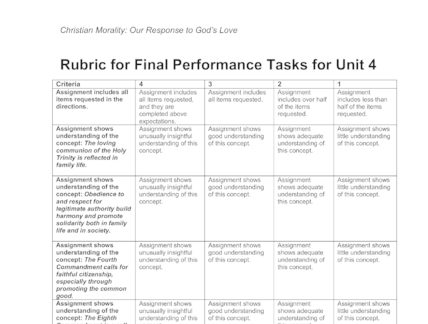
Document
Rubric for Final Performance Tasks for Unit 4
A rubric for final performance tasks for Unit 4 of "Christian Morality: Our Response to God's Love."
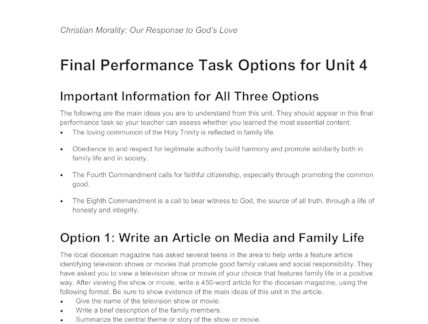
Document
Final Performace Task Options for Unit 4
A number of final performance task options for Unit 4 of "Christian Morality: Our Response to God's Love."
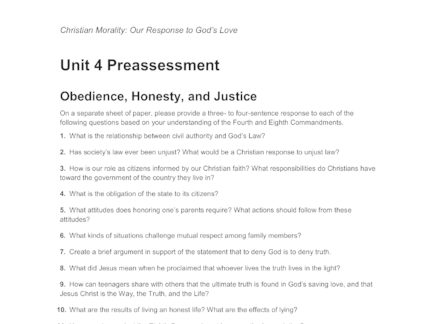
Document
Unit 4 Preassessment
A preassessment for Unit 4 of "Christian Morality: Our Response to God's Love."
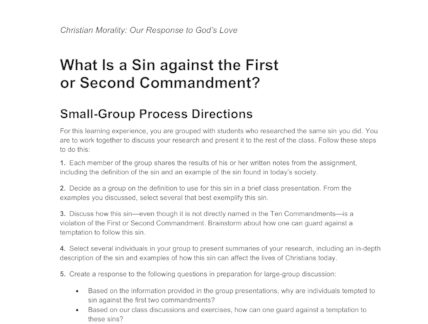
Document
What is a Sin against the First and Second Commandment
A small group activity on sins against the first and second commandment, from "Christian Morality: Our Response to God's Love."
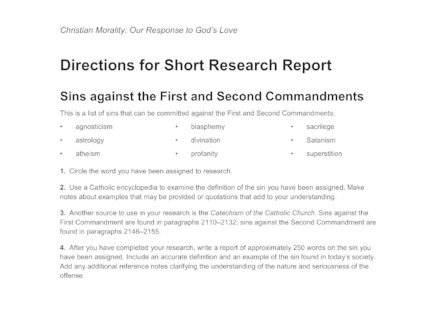
Document
Directions for Short Research Report
Directions for a short research report dealing with topics from "Christian Morality: Our Response to God's Love."
Document
Icons and iconography: Awe and Reverence
A research assignment dealing with icons, iconography, awe, and reverence, from "Christian Morality: Our Response to God's Love."
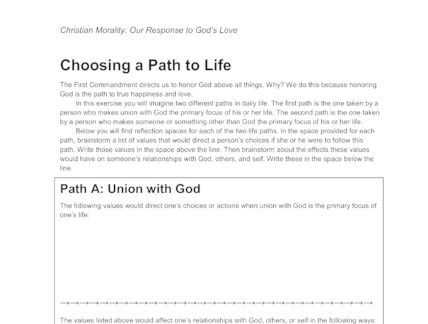
Document
Choosing a Path to Life
An exercise on choosing a path to life, from "Christian Morality: Our Response to God's Love."
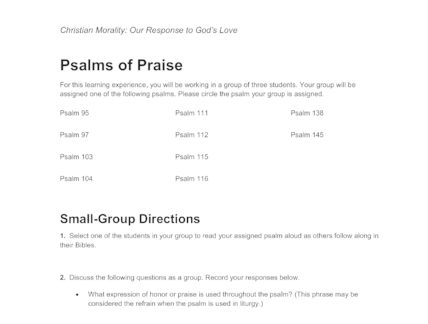
Document
Psalms of Praise
An activity dealing with the Psalms of Praise, from "Christian Morality: Our Response to God's Love."
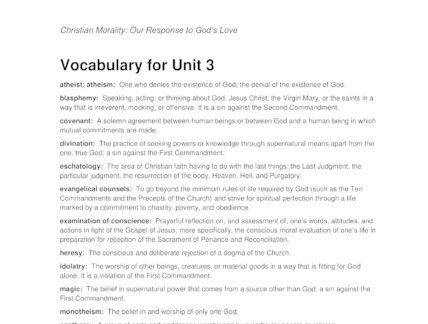
Document
Vocabulary for Unit 3
Vocabulary terms for Unit 3 of "Christian Morality: Our Response to God's Love."
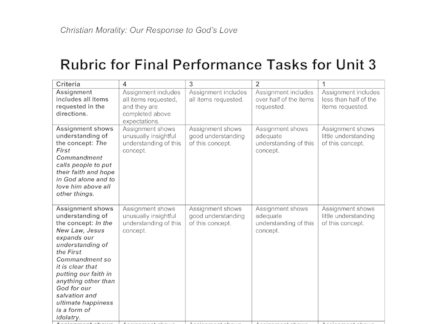
Document
Rubric for Final Performace Tasks for Unit 3
A rubric for final performance tasks for Unit 3 of "Christian Morality: Our Response to God's Love."
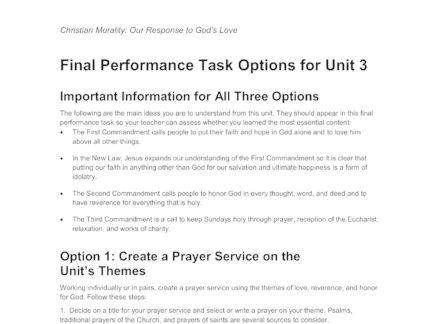
Document
Final Performance Task Options for Unit 3
Final performance task options for Unit 3 of "Christian Morality: Our Response to God's Love."
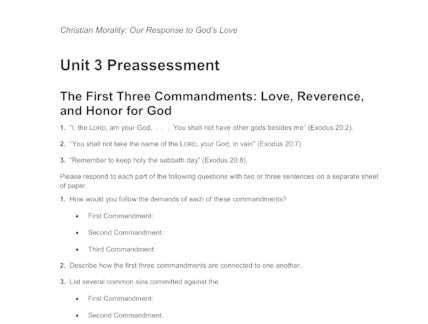
Document
Unit 3 Preassassment
A preassessment for Unit 3 of "Christian Morality: Our Response to God's Love."
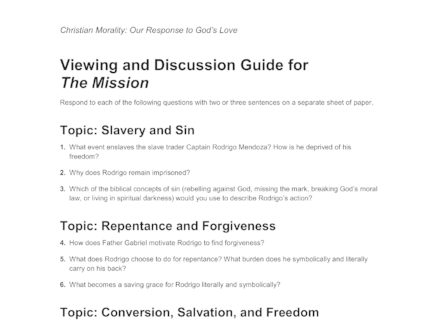
Document
Viewing and Discussion Guide for The Mission
A viewing and discussion guide for the film "The Mission", from "Christian Morality: Our Response to God's Love."
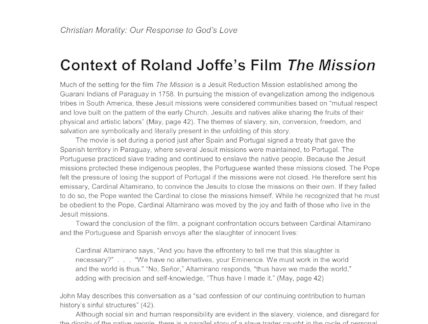
Document
Context of Roland Joffes Film The Mission
The context of Roland Joffes film, "The Mission," from "Christian Morality: Our Response to God's Love."
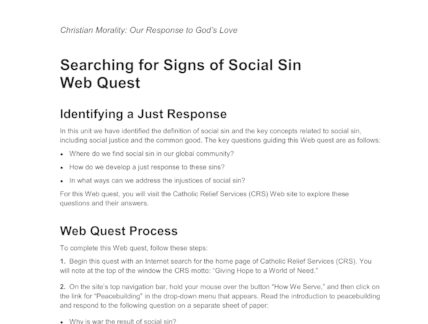
Document
WebQuest Searching for Signs of Social Sin
A WebQuest on searching for signs of social sin, from "Christian Morality: Our Response to God's Love."
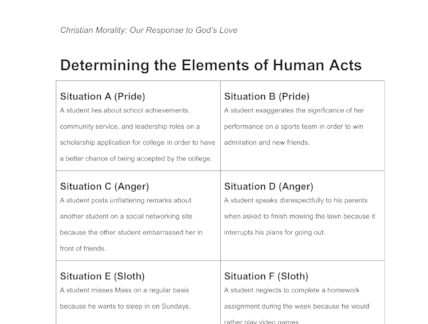
Document
Determing the Elements of Human Acts
A worksheet on determining the elements of human acts from "Christian Morality: Our Response to God's Love."
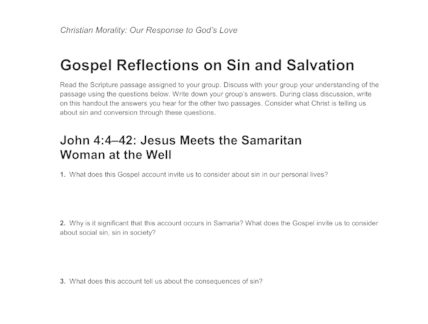
Document
Gospel Reflection on Sin and Salvation
A Gospel reflection on sin and salvation from "Christian Morality: Our Response to God's Love."
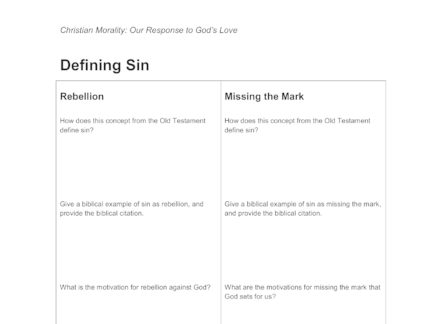
Document
Defining Sin
A worksheet on defining sin from "Christian Morality: Our Response to God's Love."

Document
Vocabulary for Unit 2
Vocabulary terms for Unit 2 of "Christian Morality: Our Response to God's Love."
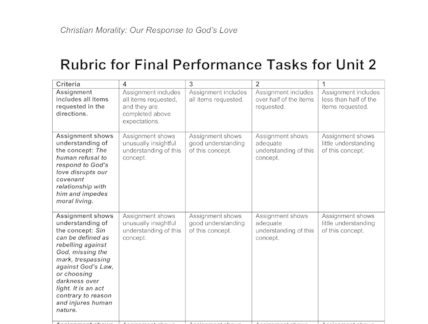
Document
Rubric for Final Performace Tasks for Unit 2
A rubric for the final performance tasks for Unit 2 of "Christian Morality: Our Response to God's Love."
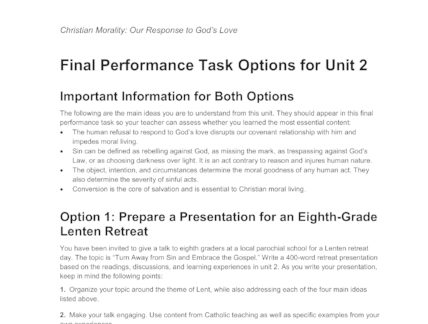
Document
Final Performance Task Options for Unit 2
Final performance task options for Unit 2 of "Christian Morality: Our Response to God's Love."
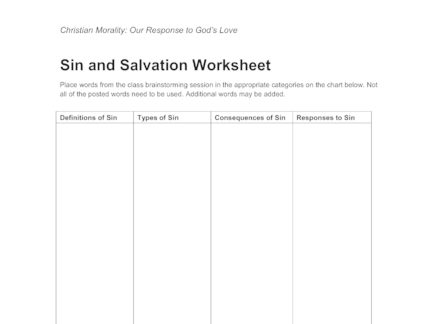
Document
Sin and Salvation
A worksheet on sin and salvation from "Christian Morality: Our Response to God's Love."
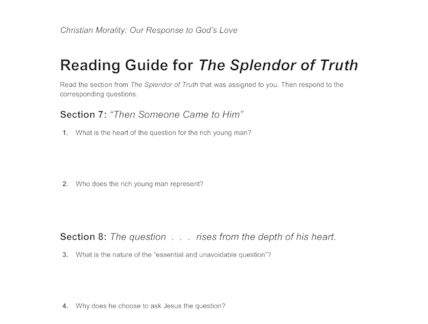
Document
Reading Guide for the Splendor of the Truth
A reading guide for the Splendor of Truth from "Christian Morality: Our Response to God's Love."
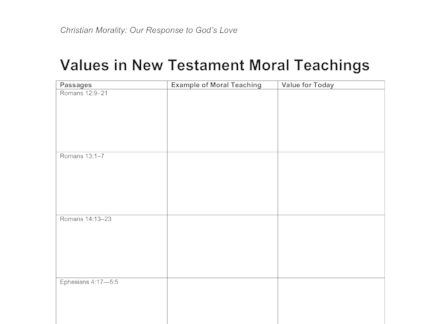
Document
Values in New Testament Moral Teachings
A worksheet on values in New Testament moral teachings from "Christian Morality: Our Response to God's Love."
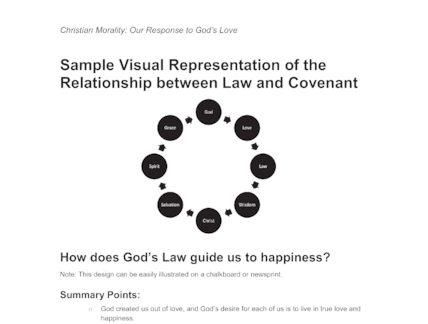
Document
Visual Representation of the Relationship between Law and Covenant Example
A visual representation of the relationship between law and covenant, from "Christian Morality: Our Response to God's Love."
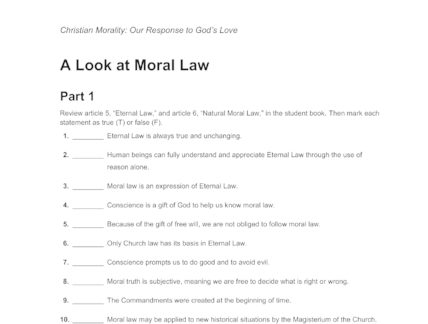
Document
A Look at Moral Law
A look at moral law from "Christian Morality: Our Response to God's Love."
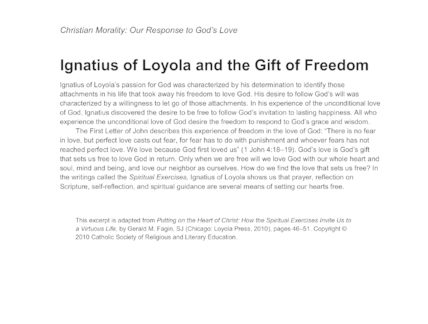
Document
Ignatius of Loyola and the Gift of Freedom
A reading on Saint Ignatius of Loyola and the Gift of Freedom, from "Christian Morality: Our Response to God's Love."

Document
Reviewing the Foundations of Christian Morality
A review sheet on the Foundations of Christian Morality from "Christian Morality: Our Response to God's Love."
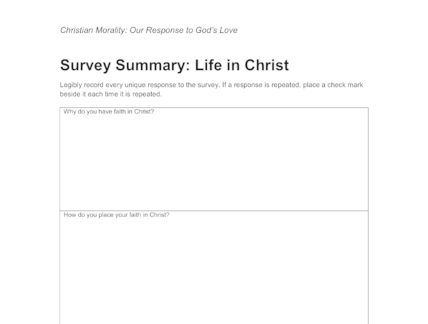
Document
Survey Summary Life in Christ
A survey summary for "Christian Morality: Our Response to God's Love."
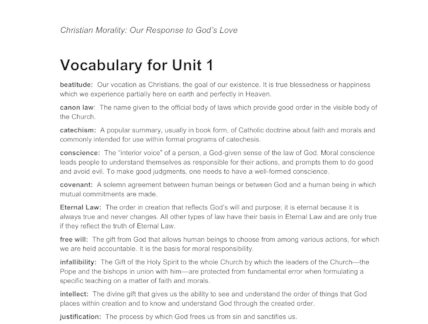
Document
Vocabulary for Unit 1
A vocabulary list for Unit 1 of "Christian Morality: Our Response to God's Love."
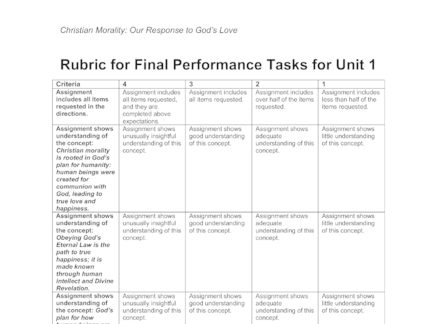
Document
Rubric for Final Performace Tasks for Unit 1
A rubric for Final Performance Tasks for Unit 1 of "Christian Morality: Our Response to God's Love."
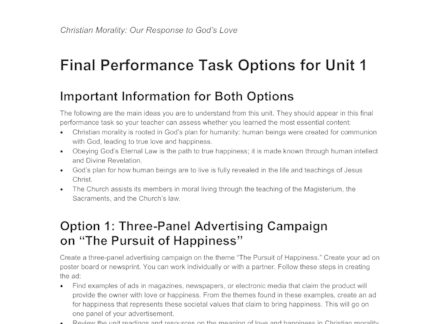
Document
Final Performance Task for Unit 1
A final performance task for Unit 1 of "Christian Morality: Our Response to God's Love."
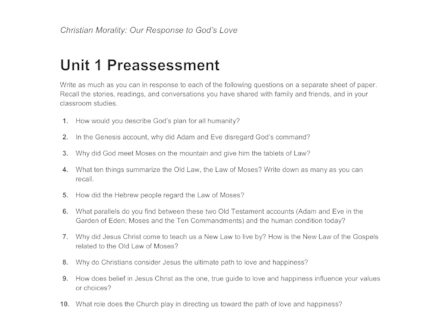
Document
Unit 1 Preassessment
A preassessment for Unit 1 of "Christian Morality: Our Response to God's Love."
Video
Words of Jesus: Catholic Social Justice - CF
Video
WE CRY JUSTICE! Trailer
Video
Saint Mother Teresa: The Legacy Trailer
Video
Catonsville Nine
Video
Join JVC
Video
Pedro Arrupe 5 of 5
Video
Pedro Arrupe 4 of 5
Video
Pedro Arrupe 3 of 5
Video
Pedro Arrupe 2 of 5
Video
Pedro Arrupe 1 of 5
Video
Jason Evert On Twilight
Video
The Dump Him List
Video
EWTn Live - Therese - the Movie - Fr. Mitch Pacwa, S.J. with Leonardo Defilippis - 12-08-10
Video
EWTN Live - The History of the Jesuits - Fr. Mitch Pacwa, SJ w Fr. John Padberg, SJ - 03-30-2011
Video
Video: Dorothy Day
This video briefly describes the character and actions of Catholic activist Dorothy Day.
Click above to access this online resource for Live Jesus in Our Hearts: Revelation and the Old Testament.
Revelation and the Old Testament is the first semester course in the new high school series Live Jesus in Our Hearts. This series takes a fresh approach to the Framework outline, bringing in new themes such as in-depth use of scripture, extensive online resources, and an invitational, evangelizing approach.
Are you interested in seeing how we're reframing framework? Learn more about Live Jesus in Our Hearts!
Video
Fr. James Groppi and the Historic 1967-68 Open Housing Campaign in Milwaukee
Video
10 Principles in the Social Teaching of the Church
Video
Catholic Relief Services - General Awareness Video
Video
Jason Evert - What is Chastity?
Video
Jason Evert - Getting Over the Past
Video
Jason Evert - Breaking the Porn Attraction
Video
Jason Evert - Modesty and Romance
Video
Digital Story - Bartolome de las Casas
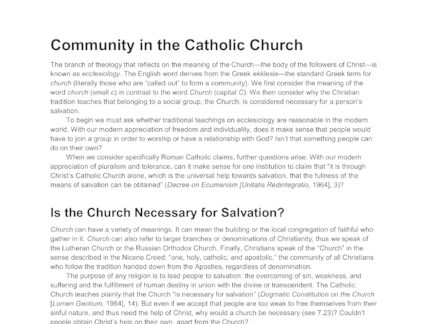
Document
Community in the Catholic Church
This article is from the Living in Christ Series. It discusses the social nature of the Catholic Church, especially with reference to community and salvation.
Presentation
Discipleship - PowerPoint
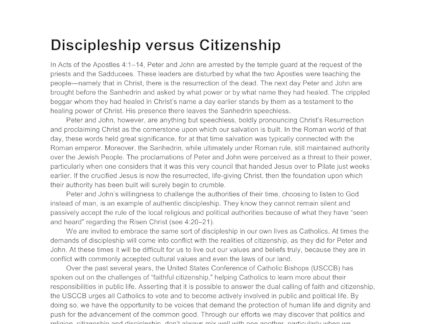
Document
Discipleship versus Citizenship
This is a short article from the Living in Christ Series. It discusses the differences between citizenship and discipleship.
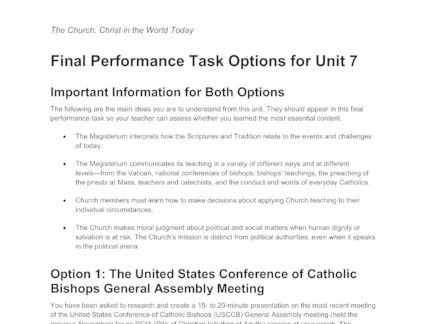
Document
Final Performance Task Options for Unit 7
This resouce is part of the Living in Christ Series. It offers various project ideas for students who are or have been studying ecclesiology, especially the role of the Magisterium on matter of faith and morals.
Presentation
Church in the World - PowerPoint
This PowerPoint is part of the Living in Christ Series. It discusses the Church in the modern world, including contentious moral issues, politics, and evangelization.
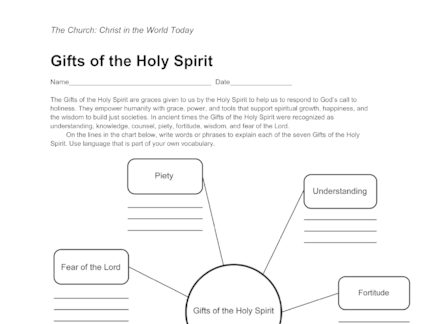
Document
Gifts of the Holy Spirit
This worksheet is part of the Living in Christ Series. Students can learn about the 7 Gifts of the Holy Spirit and use their own words to describe what each gift is.
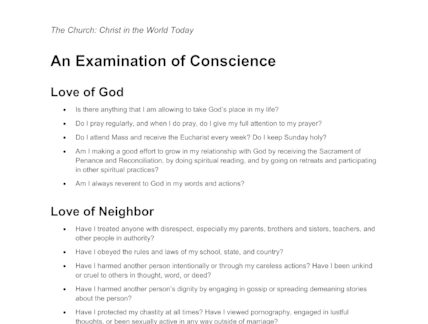
Document
An Examination of Conscience
This resource is part of the Living in Christ Series. It offers great reflection questions for going through an examination of conscience, dividing the questions into those referring to love of God, and those referring to love of neighbor. This …
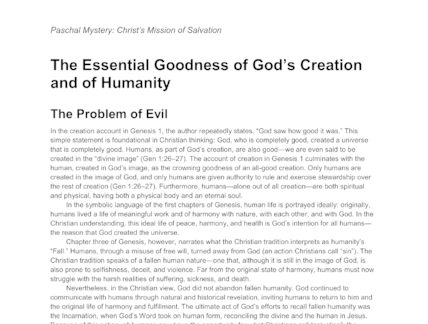
Document
The Essential Goodness of God's Creation and of Humanity
This article is part of the Living in Christ Series. It discusses the problem of evil, original sin, human freedom and the goodness of God's creation.
Presentation
Effects of Grace - PowerPoint
This PowerPoint is part of the Living in Christ Series. It presents information on the effects of sin and the effects of grace on human relationships with God, others, and self.
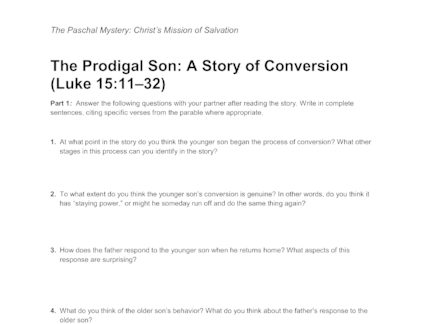
Document
The Prodigal Son A Story of Conversion
This worksheet is part of the Living in Christ Series. Students can reflect on and answer questions about the conversion of the Prodigal Son.
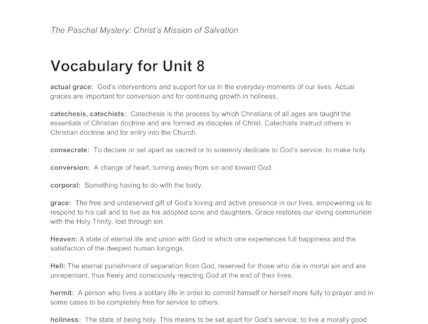
Document
Vocabulary for Unit 8
This vocabulary list is part of the Living in Christ Series. Students may use it as a reference for key theological terms to know.

Document
Rubric for Final Performance Tasks for Unit 8
This rubric is part of the Living in Christ Series. It serves as a guide for assessing students on projects about the Paschal Mystery, especially the role of community and member of the Church to live out their call to …
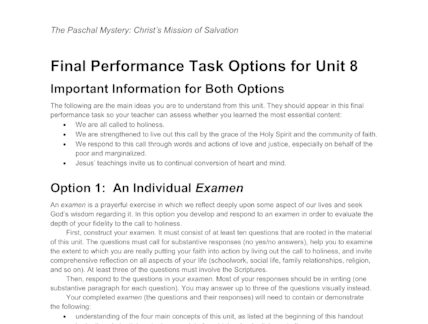
Document
Final Performance Task Options for Unit 8
This resource is part of the Living in Christ Series. It offers various project ideas for students who are or have been studying the Paschal Mystery, especially with regard to discipleship, vocation, and holiness.
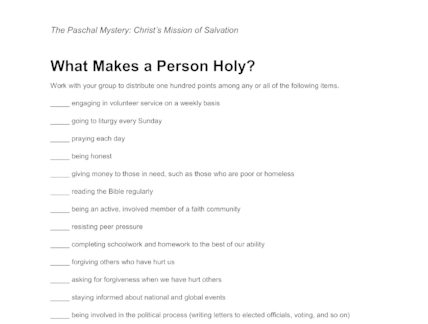
Document
What Makes a Person Holy?
This activity is part of the Living in Christ Series. Students must think critically about what habits make a person holy.

Document
Called to Holiness: Holiness in Modern Church Teaching
This article from the Living in Christ Series discusses holiness: what it is, who is called, and how to live it out. Both the Church and the people in it are holy.
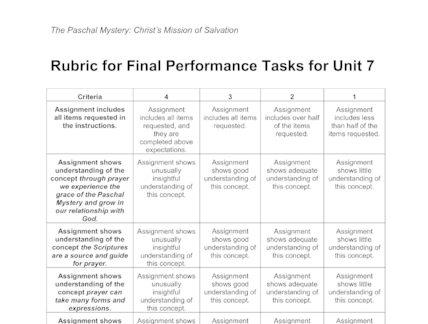
Document
Rubric for Final Performance Tasks for Unit 7
This rubric is part of the Living in Christ Series. It serves as a guide for assessing students on projects about the Paschal Mystery, focusing especially one's relationship with God through prayer and community.
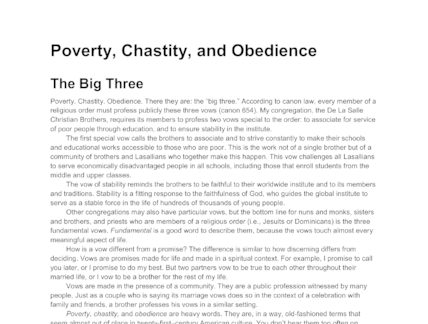
Document
Poverty, Chastity, and Obedience
This article is from the Living in Christ Series. It discusses the vows of poverty, chastity, and obedience that all religious take as part of their vocation.
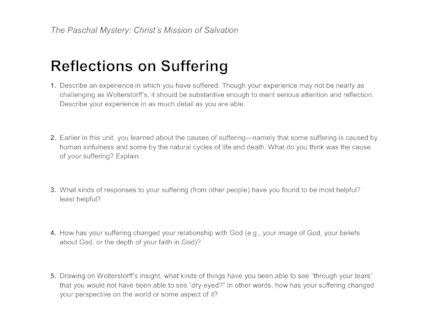
Document
Reflections on Suffering
This activity is part of the Living in Christ Series. Students can reflect on their experiences of and response to suffering through this series of though-provoking questions.

Document
Vocabulary for Unit 6
This vocabulary list is part of the Living in Christ Series. Students may use it as a reference for key theological terms to know.
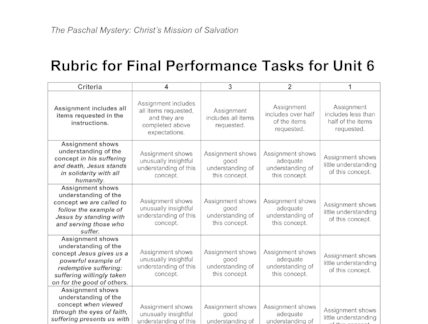
Document
Rubric for Final Performance Tasks for Unit 6
This rubric is part of the Living in Christ Series. It serves as a guide for assessing students on projects about the Paschal Mystery, especially the themes of suffering, redemption, grace, and the model of Jesus.
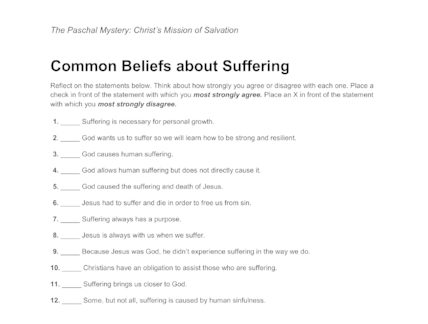
Document
Common Beliefs about Suffering
This activity allows students to reflect on a series of questions about human suffering and God's participation in it. They can agree or disagree with various statements of commonly held beliefs about suffering.
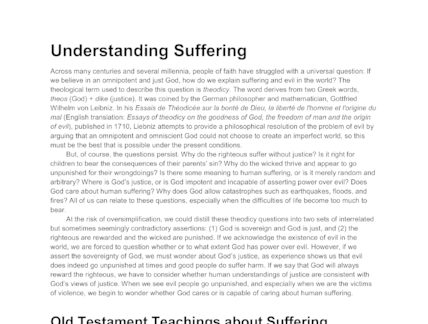
Document
Understanding Suffering
This article is part of the Living in Christ Series. It gives a thorough introduction to the concept of suffering in the Bible using scripture passages.
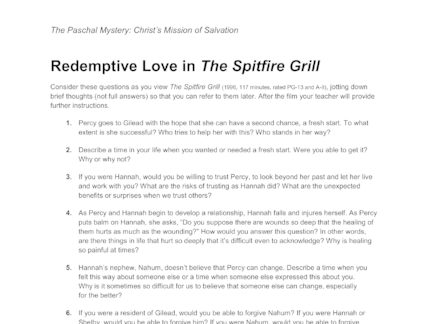
Document
Redemptive Love in The Spitfire Grill
This worksheet is part of the Living in Christ Series. Students can answer questions about the themes and characters in the movie, "The Spitfire Grill".

Document
Vocabulary for Unit 3
This vocabulary list is part of the Living in Christ Series. Students may use it as a reference for key theological terms to know.
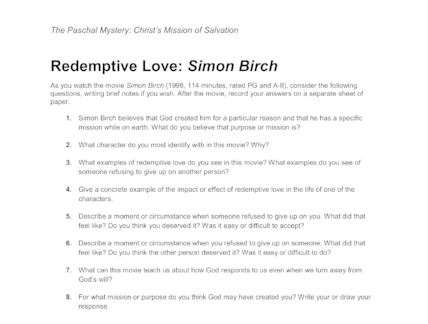
Document
Redemptive Love: Simon Birch
This activity is part of the Living in Christ Series. Students watching the movie "Simon Birch" can use this handout to follow along and reflect on major themes in the film.
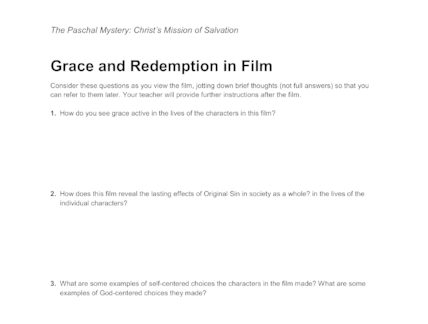
Document
Grace and Redemption in Film
This handout is part of the Living in Christ Series. It asks a series of questions about various characters and themes of grace, redemption and suffering. Suggested movies for this activity include "Amazing Grace" and "Dead Man Walking."

Document
Vocabulary for Unit 1
This vocabulary list is part of the Living in Christ Series. Students may use it as a reference for key theological terms to know.
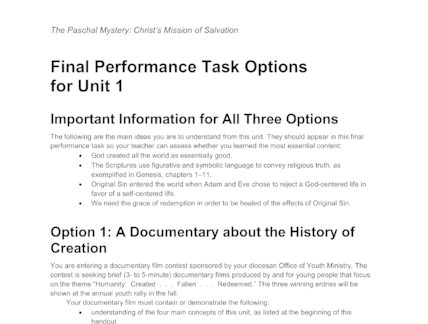
Document
Final Performance Task Options for Unit 1
This resource is part of the Living in Christ Series. It offers ideas for a final assessment for students who have been learning about the Paschal Mystery.
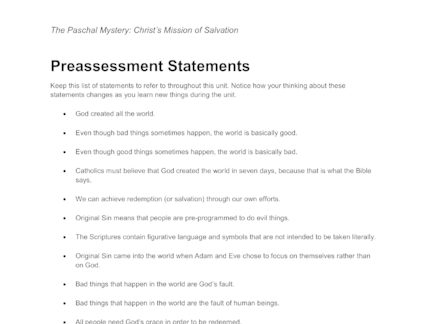
Document
Preassessment Statements
This activity is part of the Living in Christ Series. It offers several statements with which students may agree or disagree as a preassessment tool for teaching the Paschal Mystery.
Presentation
Being Human - PowerPoint
This PowerPoint is part of the Living in Christ Series. It asks students to reflect on what it means to be human and how Jesus models the way to live fully alive.
Presentation
The Greatest Commandments - PowerPoint
This PowerPoint is part of the Living in Christ Series. It explores the Greatest Commandments, especially in the way they focus on God, other, agape, and the Ten Commandments.

Document
Where Have Jesus, Mary, the Apostles, Disciples, and Others Modeled the Ways to Discipleship?
This activity is part of the Living in Christ Series. Students are asked to reflect on the discipleship modeled by Jesus, Mary, the Apostles, and others.
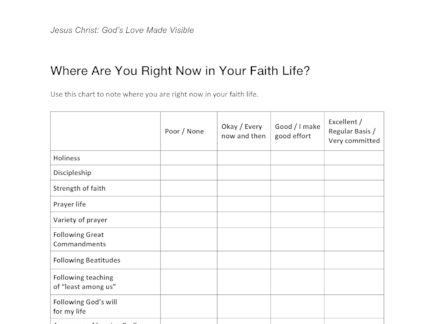
Document
Where Are You Right Now in Your Faith Life?
This activity is part of the Living in Christ Series. Students are asked to reflect on their own habits and practices in their spiritual journey.
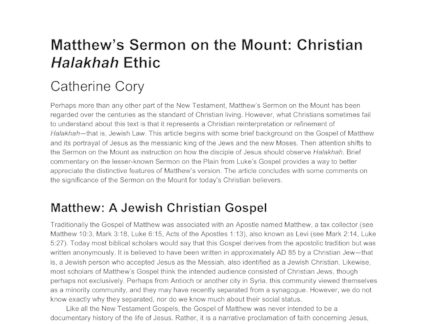
Document
Matthew's Sermon on the Mount
This article is part of the Living in Christ Series. It offers an overview of Jesus' Sermon on the Mount through the lens of Matthew's Jewish audience and signifance.
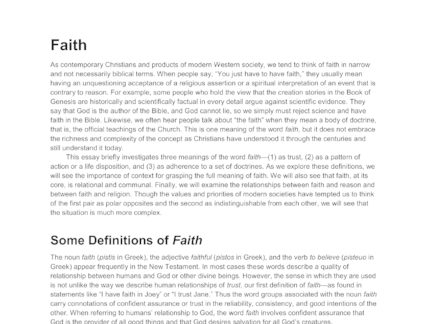
Document
Faith: Three Definitions
This article is from the Living in Christ Series. It discusses various definitions of faith, the relationships between faith and reason, and faith and religion.
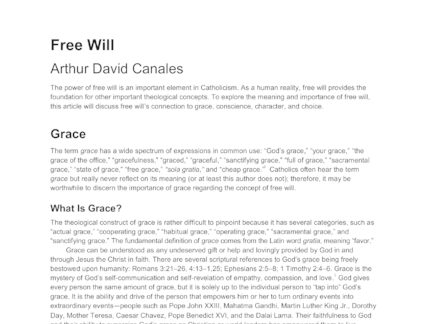
Document
Free Will
This article is from the Living in Christ Series. It discusses the relationship between free will and grace, the conscience, character, and human choices.
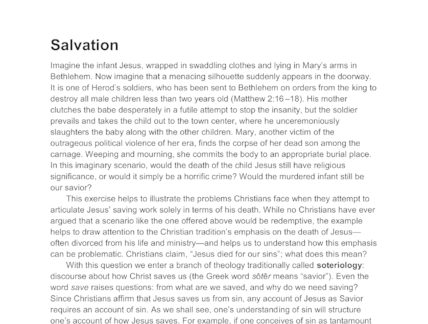
Document
Salvation: Different Theories
This article is part of the Living in Christ Series. It offers an overview of some of the main theories of salvation, including the Prophetic, Sacrificial, Ransom, Divinization, Vicarious, Moral Exemplar, and Penal Substitution models.
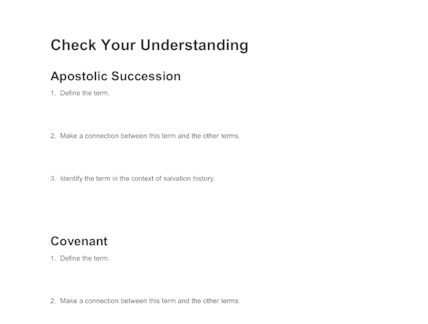
Document
Check Your Understanding
This activity is part of the Living in Christ Series. It serves as a review of several important terms and asks students to define, associate, and put the term into the context of Salvation History.
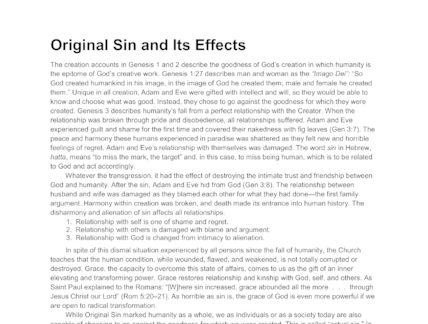
Document
Original Sin and Its Effects
This article discusses original sin, the effects of sin on relationships, and the criteria with which to make a moral judgment.
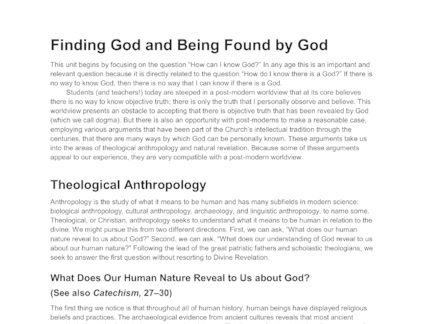
Document
Finding God and Being Found by God
This article is part of the Living in Christ Series. It discusses how God is revealed in humanity, creation, nature, the natural order, and the human conscience, and humanity is likewise revealed in God. It uses the Catechism of the …
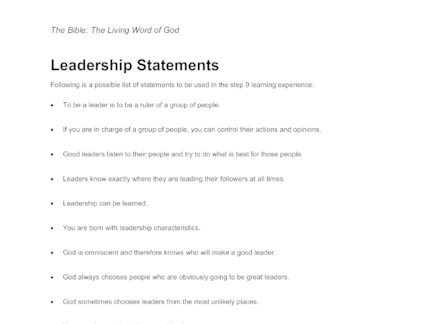
Document
Leadership Statements
This worksheet is part of the Living in Christ Series. It includes several statesments about leadership in the Bible, including who's called, what skills are necessary, and what it takes to be a good leader.
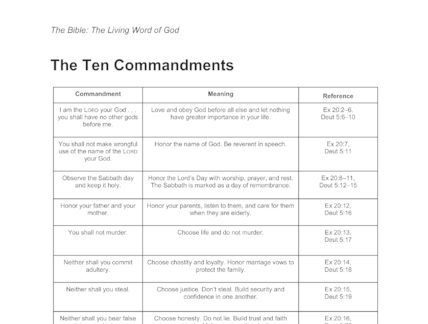
Document
The Ten Commandments
This handout is part of the Living in Christ Series. It outlines the 10 Commandments, the meaning, and the book, chapter and verse at which they are found in the Bible.
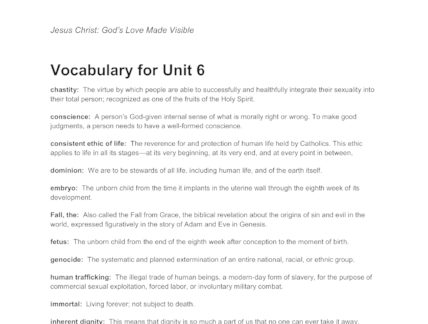
Document
Vocabulary for Unit 6
This vocabulary list is part of the Living in Christ Series. Students may use it as a reference for key theological terms to know.
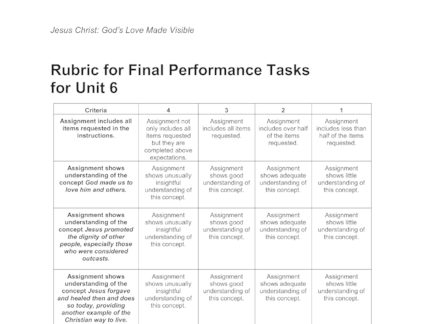
Document
Rubric for Final Performance Tasks for Unit 6
This rubric is part of the Living in Christ Series. It serves as a guide for assessing students on projects on the person of Jesus Christ, especially his teaching on morality and Christian lifestyle.
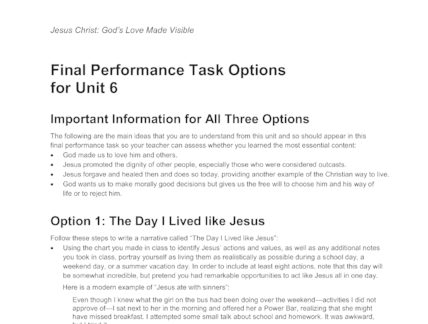
Document
Final Performance Task Options for Unit 6
This resource is part of the Living in Christ Series. It offers various project ideas for students who have recently studied christology, especially the moral teachings and model of Jesus Christ.
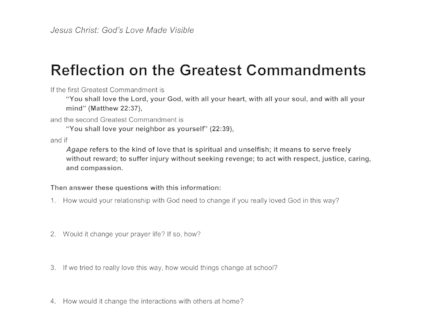
Document
Reflection on the Greatest Commandments
This worksheet is part of the Living in Christ Series. Students can study and reflect on the Greatest Commandments: to love God with your whole mind, body and soul, and to love your neighbor as yourself.
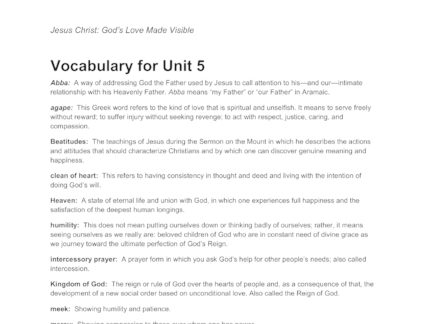
Document
Vocabulary for Unit 5
This vocabulary list is part of the Living in Christ Series. Students may use it as a reference for key theological terms to know.
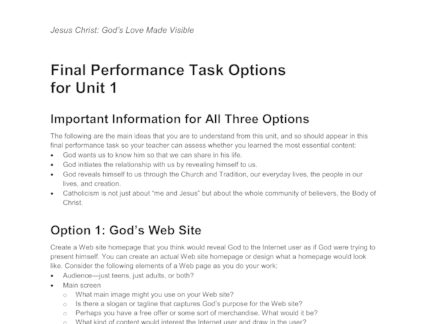
Document
Final Performance Task Options for Unit 1
This resource is part of the Living in Christ Series. It offers ideas for final assessment projects for students studying Christology, including revelation, the Church, and tradition.
Video
Jason Evert - Why Chastity?
Video
Porn - What's the Harm?
Article
Where is now thy God? Reflections on Psalm 42:7-10
Where do we find God today? How are we to understand such happenings? Some might respond by saying that everything happens for a reason. I don't buy that. Some might respond by saying that it is all part of God's …
Article
November, National Child Safety Month: Preparing for safe and sacred places
Preparing for Safe and Sacred Places Some experts predict the presence of at least one abuser and one victim of abuse anytime there is a gathering focusing on this topic. Someone in your community might be experiencing abuse of some …
Article
November, National Child Safety Month: Preventing Abuse
Ongoing Prevention and Education Your community can do several things to inform, prevent, and respond to sexual abuse. The following are essential strategies you will want to incorporate into parish- or school-wide ministries: • All young people need to know …
Article
November, National Child Safety Month: Considerations in Ministry Planning
CONSIDERATIONS IN MINISTRY PLANNING All adults who work with children and or young people must be capable of exercising good judgment and wisdom in their ministry. We recommend that you consider the following questions when planning any activity involving children …
Article
Word-Association Exercise: Afterlife
(30 minutes) Prior to this exercise, have the all participants (including the facilitator) bring to the session a personal symbol. This symbol should be an object from among the participant's personal belongings that acts as a reminder of a much …
Article
Who Does the Movie Say Killed Jesus?
Much of the controversy about The Passion of the Christ centers around one question: Who killed Jesus? The Anti-Defamation League feels the movie lays the blame at the feet of the Jews. Mel Gibson, the movie's director, producer and cowriter, …
Article
Talking Hands--Personal Attitudes Toward Death
(10 minutes) 1. Have the participants assemble and sit in a circle. Introduce this activity as Talking Hands. Explain to the participants the signals that they will need to use. Tell the young people that each time they hear a …
Article
Unbound!
OVERVIEW Praying for forgiveness sets us free. In this prayer the young people experience this message through a ritual of reconciliation. This strategy, which is ideal for a retreat or as a conclusion to a session on forgiveness, allows …
Article
January 22: Saying Yes to Life
Preparation Bring in pictures of fetal development. 1. Present a scenario in which a girl like those in your group experiences a crisis pregnancy. Then list on the board a number of options, such as these: She can keep the …
Article
Self-Esteem and Sexual Activity: The Difference Between the Sexes
The American Academy of Pediatrics recently found a major difference between boys with hgh self-esteem and girls with high self-esteem. Boys with a high self-esteem were more likely to have engaged in sexual intercourse than boys with low self-esteem. Conversely, …
Article
Let's Prove Them Wrong!
12 September 2001 As the truth unfolds behind who committed these horrendous terrorist attacks against the United States, I pray that we--as individuals and a country--will have the strength and courage to think deeply before we lash out in anger …
Article
Why Is the World the Way It Is?
Why is the world the way it is? Why is it full of wrong? Why are her eyes so big? Why is his neck so long? Why is she so dark? Why am I so light? Why is she called …
Article
Moral Decision Making and Real-Life Applications
If you have used the Saint Mary's Press textbook Growing in Christian Morality, then you're familiar with the LISTEN process for making moral decisions. The process is introduced in the textbook and is used throughout the companion student casebook. LISTEN …
Article
On the Frontier of Justice in Ghana
"Africa has been the land of hope, salvation, and redemption. Abraham had come to Africa, Joseph from slave to savior. It was the land of refuge for Jesus and helped to carry his cross. Will we continue to dismiss Africa …
Article
Patch Adams - Movie Reflection
Patch Adams is a great movie to use with students! It is the fact-based story of Hunter "Patch" Adams, the founder of the Gesundheit Clinic. Robin Williams plays the lead character with grace and skill. Synopsis: After spending some time …
Article
The Color Purple
A CAUTIONARY NOTE: One of the criticisms of The Color Purple is that it depicts the men in the story as primarily abusive. Also, this movie is PG-13, mostly because of the violence and strong language. We recommend the movie …
Article
Until a "lack of discretion" do us part
Ever since the church got involved in the wedding ceremony, relatively late in Christian history, it has stood by its main belief about a marriage. It’s the consent of the couple that binds. SEVENTH IN A 10-PART SERIES ON CHURCH …
Article
Who's Sorry Now?
For those of us old enough to remember, the phrase, "Love means never having to say you're sorry," produces a wry smile. It takes but a moment of reflection to realize the profound untruth of this statement. Life without "I'm …
Article
Everyday Works of Mercy
Are you more Christian than you give yourself credit for being? My belief is that there are many like that--that many dedicated Christian people have compartmentalized their lives and have excluded important and central areas of their lives from what …
Article
Annulments:
Mary Sue Williams and Cathy Miettunen lived just a few blocks apart in a tree-lined, middle-class neighborhood in Saint Paul, Minnesota when both went through the Catholic Church's annulment process following their civil divorces. Williams and Miettunen belonged to the …
Article
The Death Penalty and the Catholic Conscience
Some proponents say the death penalty is biblical: "an eye for an eye." This moral theologian shows how they are misreading the Bible. If someone murdered your child or closest friend, what punishment would you want for the criminal? If …
Article
Evil Never Looked So Good
Do you think you're a victim? Do you avoid making judgments because you'll hurt someone's feelings? Do you feel betrayed by your wrinkles or your balding dome? Be careful. You might be cuddling up to heresy, which just had a …
Article
Letting Go and Letting God
*last name has been changed for this article Bernie Fenton* never minded that his office overlooked a cemetery. In fact, he kind of liked it. He'd glance up from his desk now and then catching glimpses of friends and family …
Article
Jubilee Transformation and the Call to Reconciliation
The jubilee tradition has many connecting themes. One powerful current that runs through all the themes is the transformative power of God at work, reshaping our hearts and restoring our world. The hopes of the jubilee tradition are also a …
Article
Peace: The Countercultural Value
Ours is a violent society. Furthermore, evidence strongly suggests that we are learning to accept violence as normal behavior. As a people, we appear to be increasingly indifferent to daily images of warfare, racial hatred and ethnic cleansing. Murder and …
Article
Thou Shalt Not Kill: The Church Against Assisted Suicide
Will we allow doctors to become accomplices in self-destruction? That's a question the U.S. Supreme Court is facing. The results of its decision will be felt everywhere. WHEN I FIRST SAW my 39-year-old friend Jim lying in a nursing-home bed, …
Article
The Ethics of Cloning
Amazing. Maybe it's because I can still be wowed by yet another Spielberg dinosaur film. Maybe it's because I find the processes of reproduction and the inner life of DNA to be as much about mystery as they are about …
Article
Litany of Forgiveness
Before the session, cut out each of the eight prayers and accompanying Scripture passages. Place each slip of paper in a separate small envelope and seal it. There are times at school, at home, at work, or in a group …
Article
Using Literature in Theology Classes
Editor's note: The author of our feature article, Kathleen Hodapp, was one of the participants in last summer's workshop "The Catholic High School As Faith Community," held here in Winona, Minnesota, as well as on the East Coast and the …
Article
Kinds of Relationships
Margaret Kueberth, a religion teacher at the Catholic High School of Baltimore, passed on two of her exercises that can be used in a sexuality or lifestyles course. The first exercise, which can be made into a handout, serves as …
Article
The Mirror Has Two Faces
We live in a culture obsessed with sex, and our students soak up that message in music, television, and film. I am astounded at how explicit the sexual dynamics, innuendo, and situations in typical teen dramas (witness "Dawson’s Creek," "Felicity," …
Article
Curriculum Offerings of Theology Departments
For a couple of years, Saint Mary’s Press sponsored a listserv discussion group online. Discussions on a variety of topics were pursued via e-mail. In this section of the web site, I summarize some of the highlights from these old …





